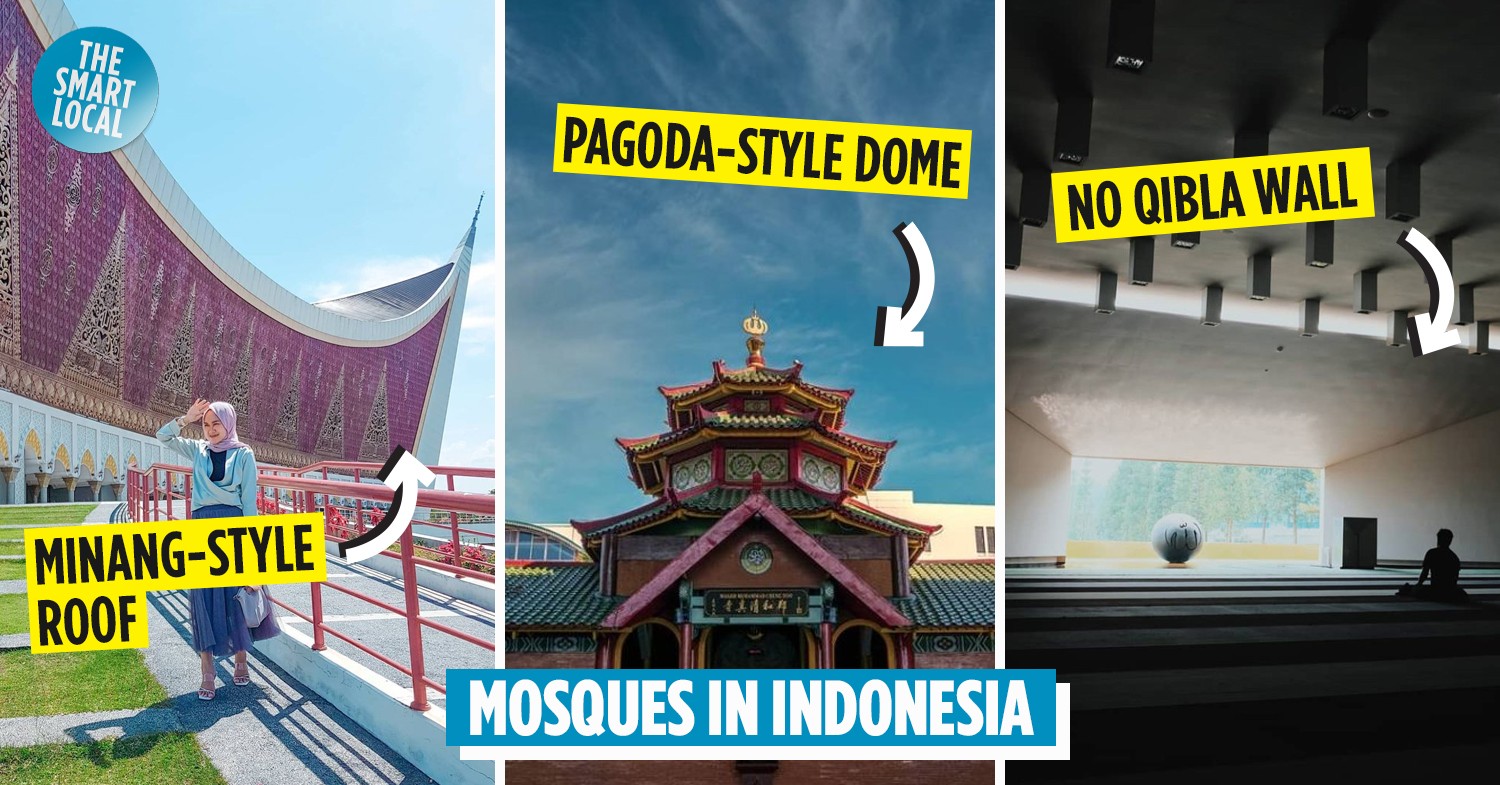Unique mosques in Indonesia
In terms of splendor, the mosques in Indonesia might not be able to match the sheer grandeur of the ones you’ll see in Saudi Arabia. But what they lack in grandeur, they make up for in originality as our country has some of the most eclectic mosques in the world.
This is partly thanks to Indonesia’s rich cultural diversity, with local architecture blending with age-old mosque designs, resulting in landmarks that are uniquely Indonesian. If you’re thinking of embarking on a spiritual journey through the country, make sure to drop by these 8 unique mosques in Indonesia.
1. Grand Mosque of West Sumatra – domeless mosque with Minang-style roofs and carvings
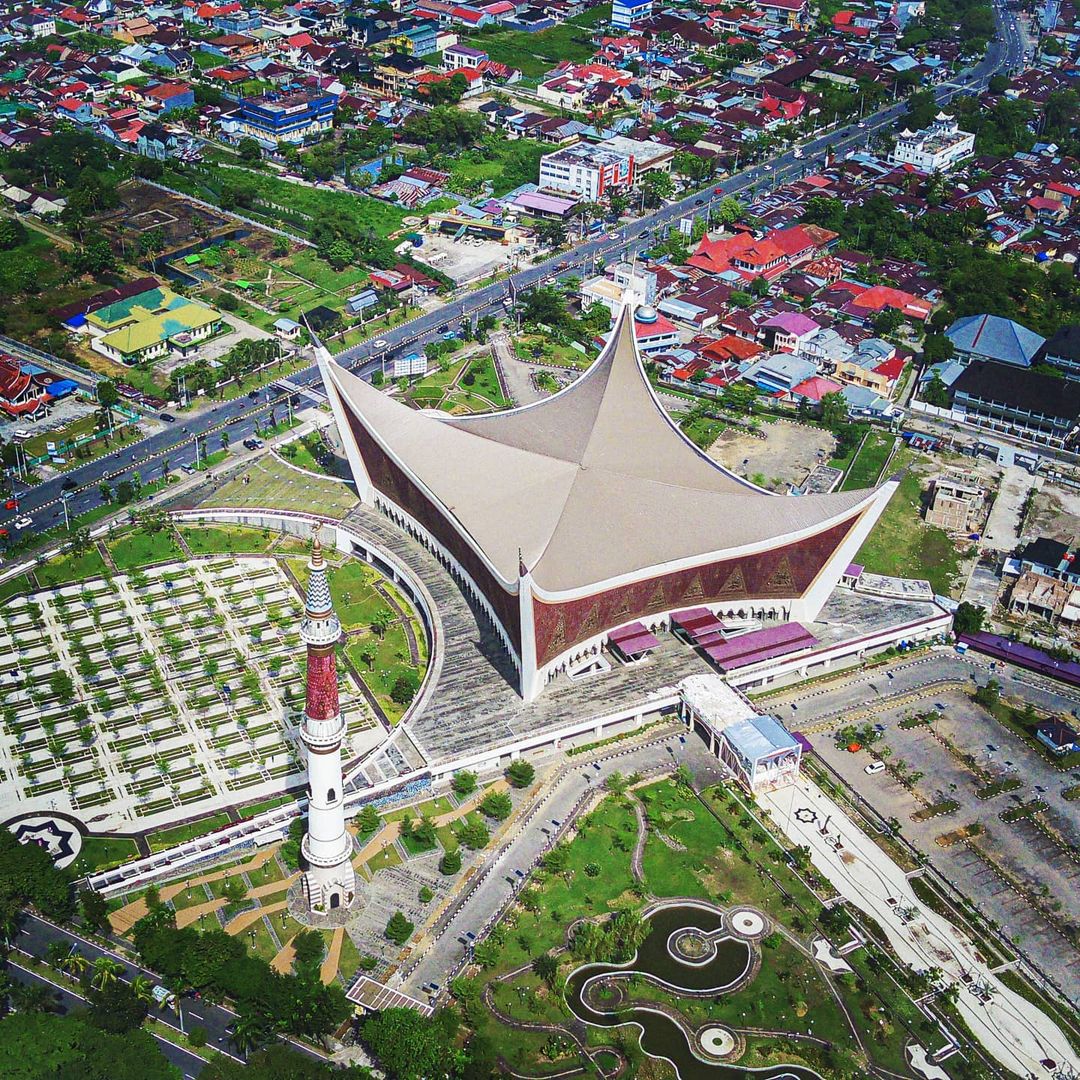
Aerial view of the whole complex
Image credit: @jeampaten_
While they’re mostly known for bringing the joys of rendang and nasi padang to the wider world, the Minang people have so much more to offer than drool-worthy food. The Grand Mosque of West Sumatra in Padang showcases another facet of their culture through its unique architecture.
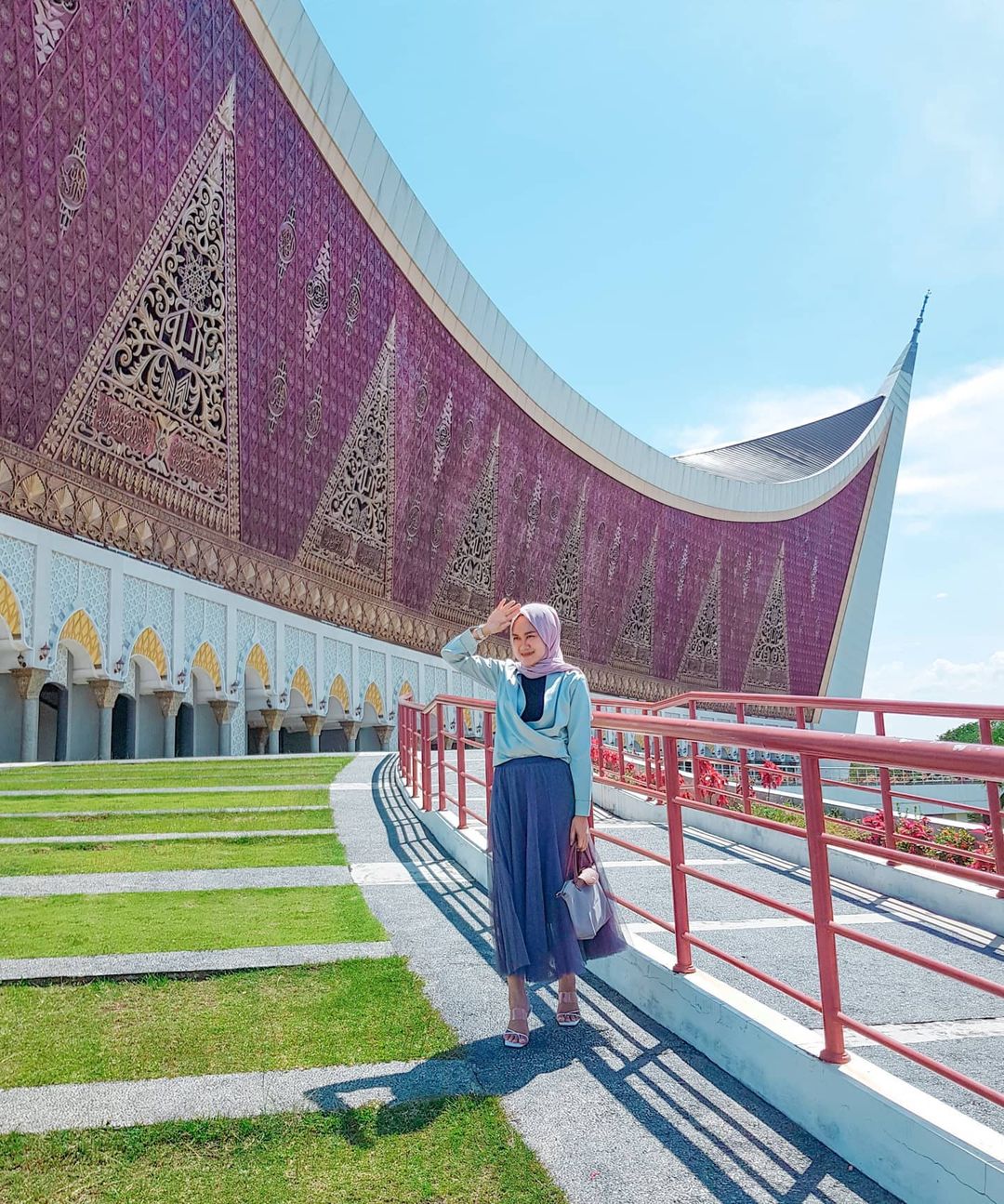
If you look closely, you can make out Islamic calligraphy along the mosque’s facade
Image credit: @dienawasool_dienakitchen
In lieu of a typical dome, the mosque adopts a Minang–style roof known as gonjong akin to their traditional Rumah Gadang. The facade is also decorated with traditional Minang carvings adorned with various Islamic calligraphic works.
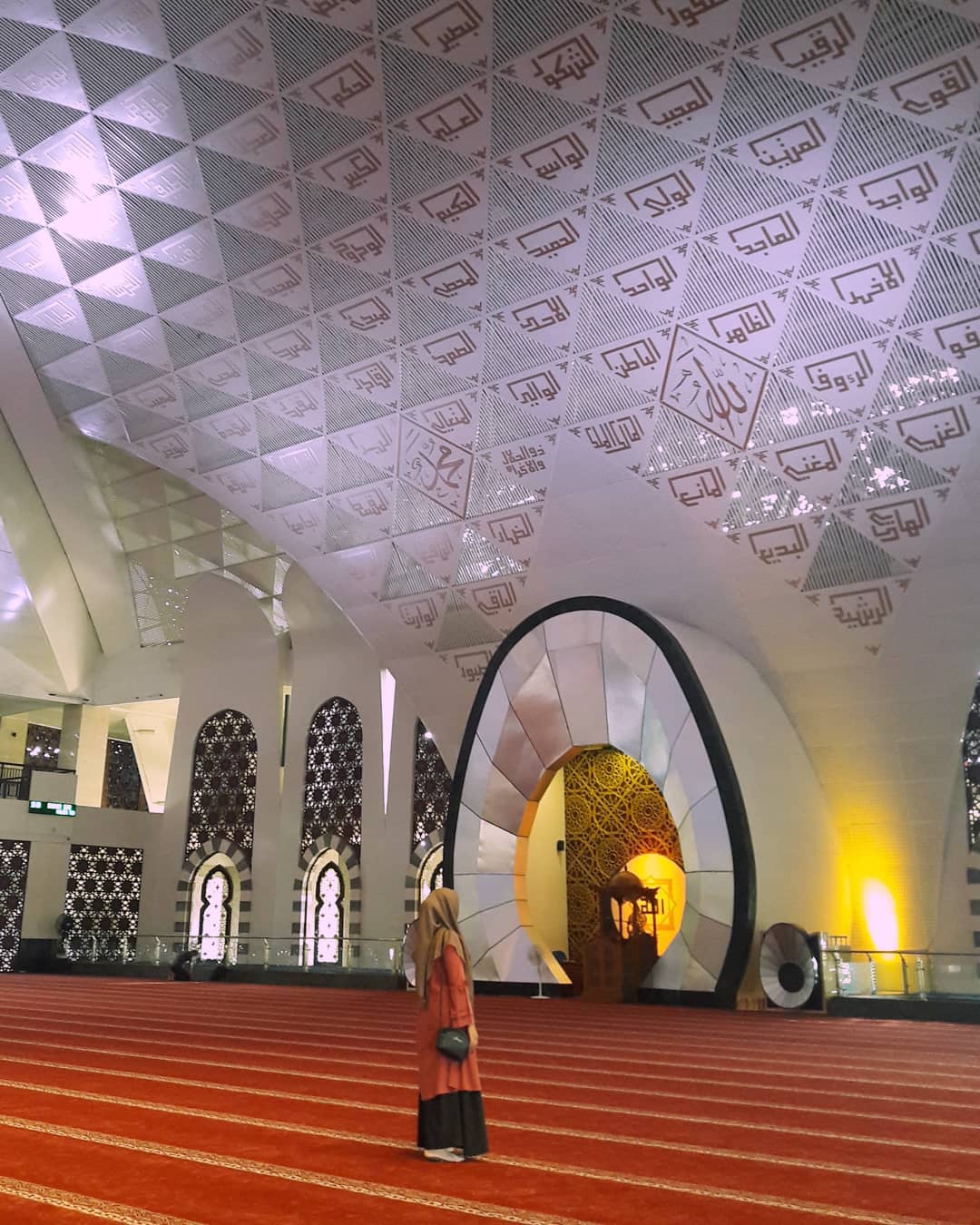
The mihrab is shaped after the Black Stone of Mecca
Image credit: @miftadahlan
The interior too is equally gorgeous, with the mihrab, the niche in the qibla wall that Muslims face when praying, shaped after the Black Stone of Mecca. Extending from the mihrab are numerous gold calligraphic works denoting the 99 Names of God reaching all the way up to the mosque’s ceiling.
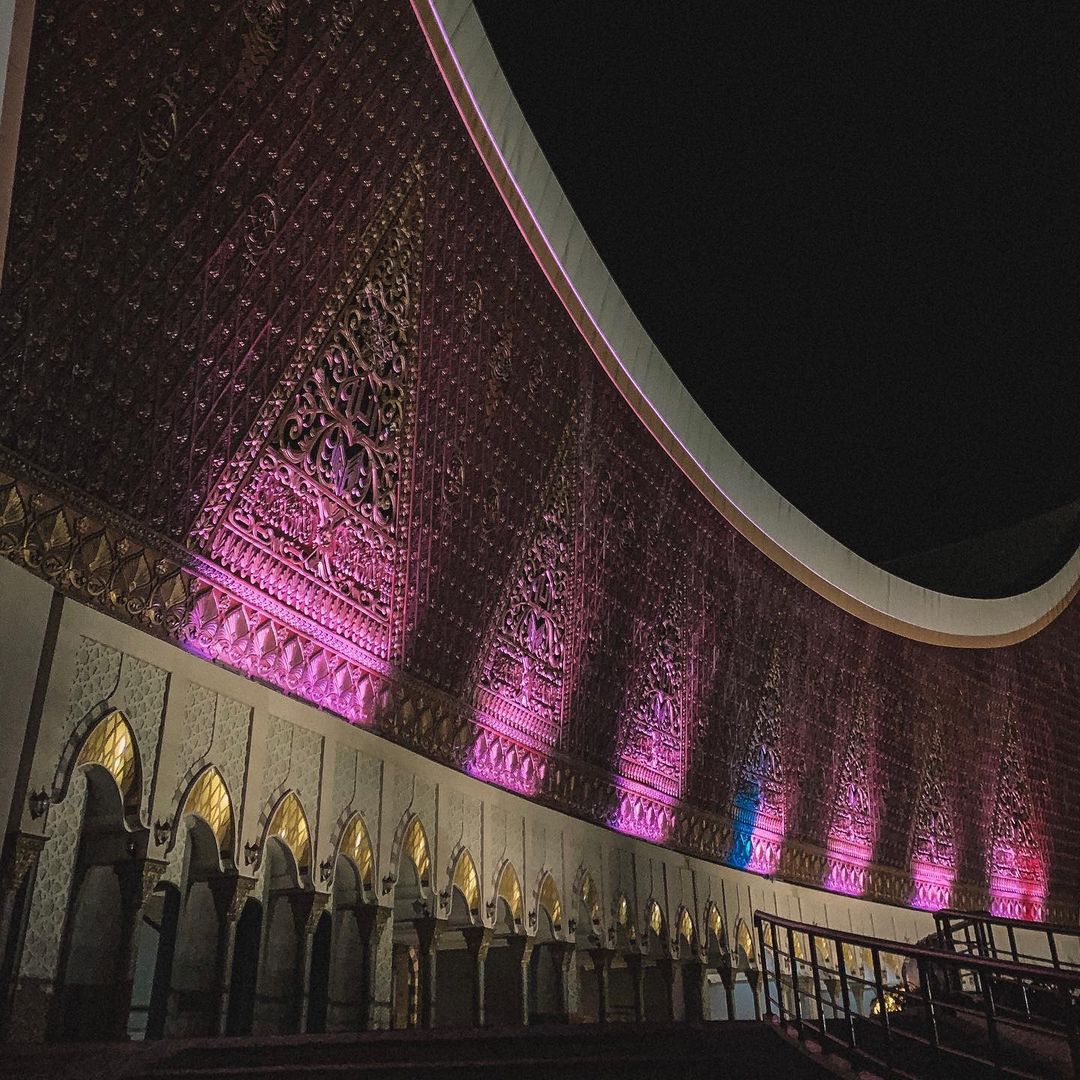
Make sure to stay past sunset if you’d like to spot the mosque’s colorful lights
Image credit: @rbraggi
If you’re there, try to stick around past sunset as the mosque’s colorful lights viewed from the surrounding garden make for quite a pretty sight. In fact, we recommend exploring the surrounding gardens as well, giving you the opportunity to take in the mosque’s unique architecture from every possible angle.
Address: Jl. Khatib Sulaiman, Alai Parak Kopi, Kec. Padang Utara, Kota Padang, Sumatera Barat 25173
Opening hours: 24 hours, Daily
2. Central Java Grand Mosque – a mix of Roman, Javanese, and Islamic architecture
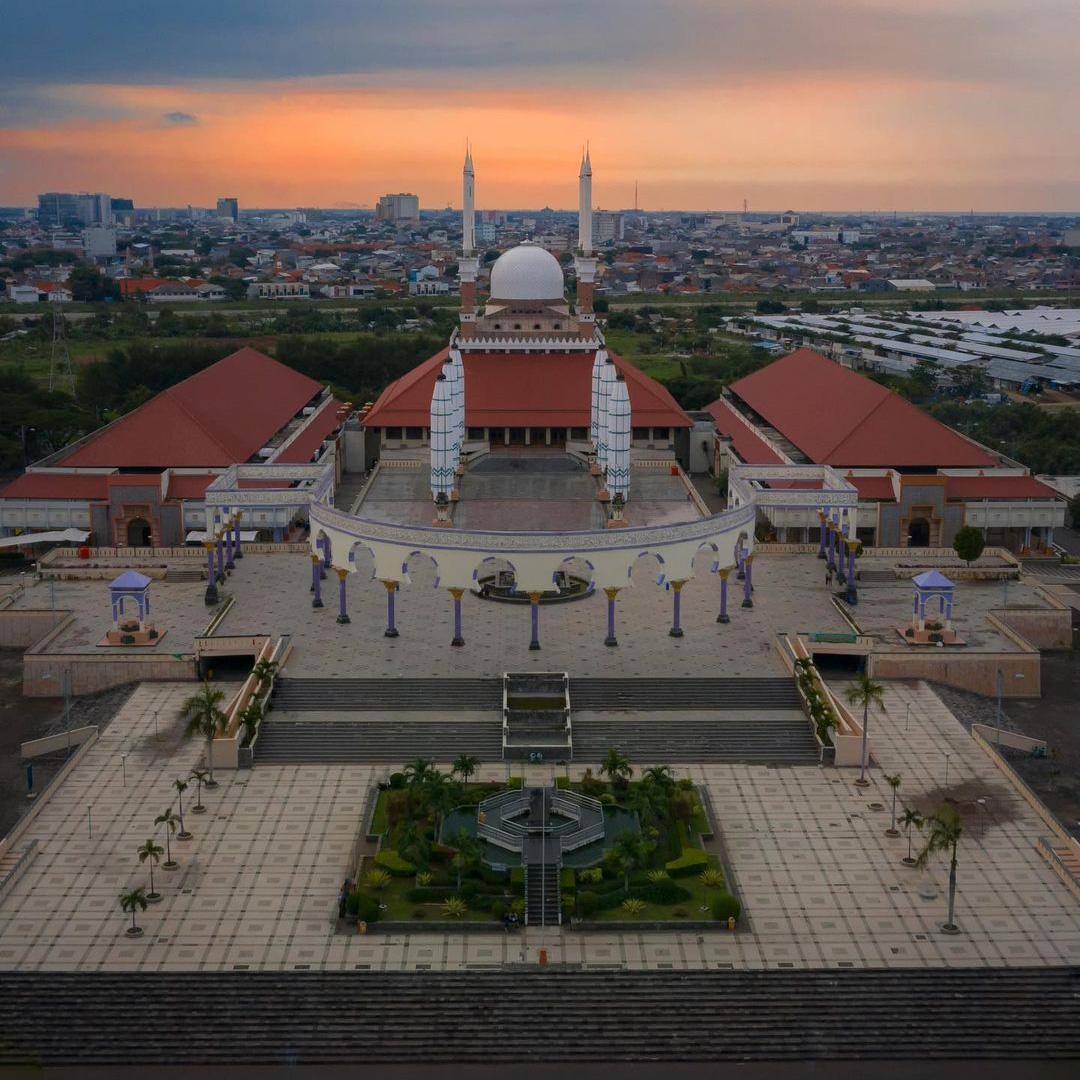
Aerial view of the mosque
Image adapted from @toni.liu29
With designs inspired from all over the world, the grand, U-shaped Central Java Grand Mosque is one of the most eclectic places of worship in the country. The pyramid-like roof of the central building is inspired by the traditional house of Javanese people, or the Joglo, a common sight in the surrounding city of Semarang.
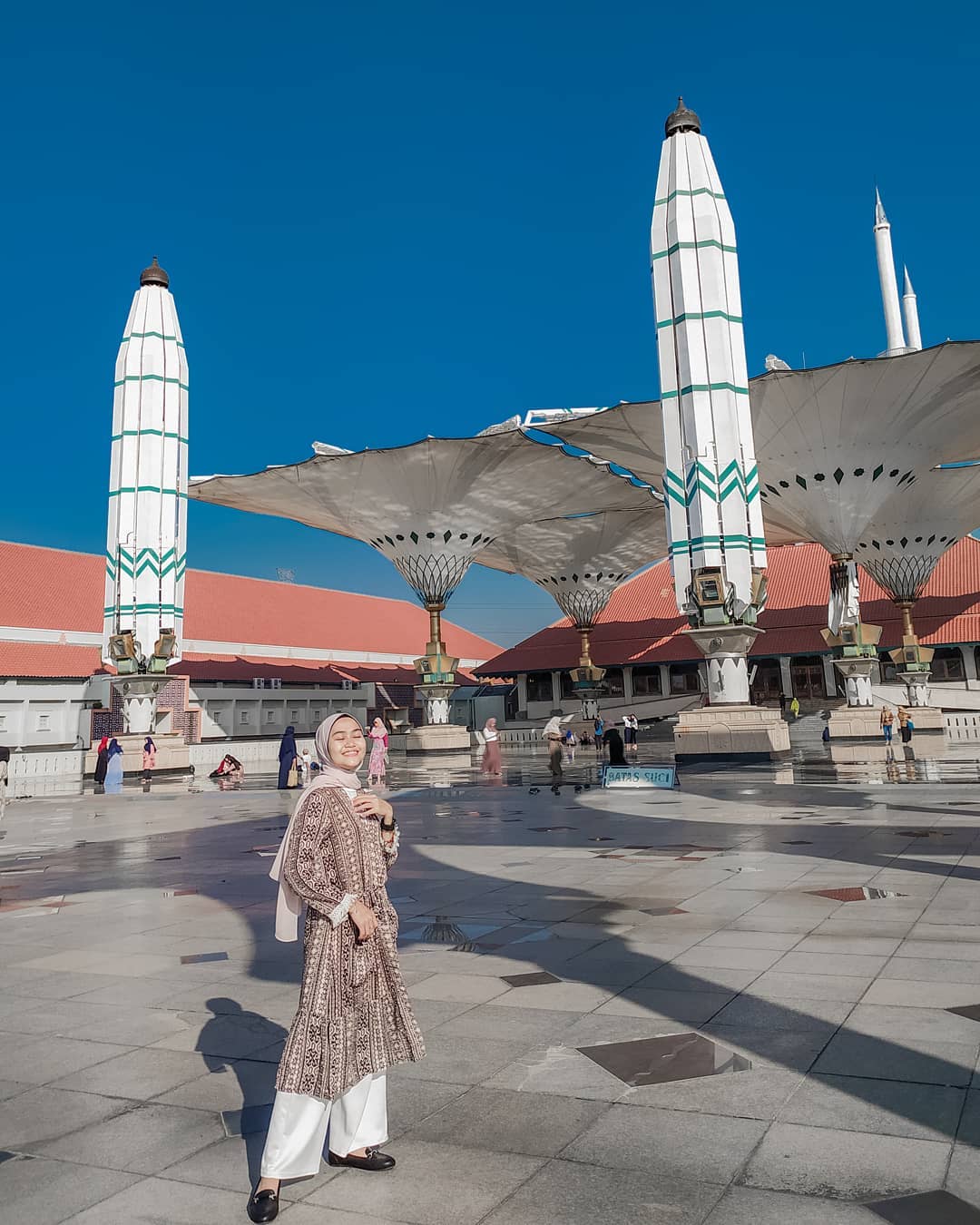
The hydraulic umbrellas aren’t always extended so count yourself lucky if you happen to be there while they are
Image credit: @apang_selei
In front of the main building lies the mosque’s central courtyard with six gigantic umbrellas akin to the ones in Masjid Al-Nabawi in Medina, Saudi Arabia, the resting place of the Prophet Muhammad. Do note that when the sun’s out, walking barefoot across the pretty white marble floors of the courtyard can be quite a challenge and a pair of socks would be most helpful.
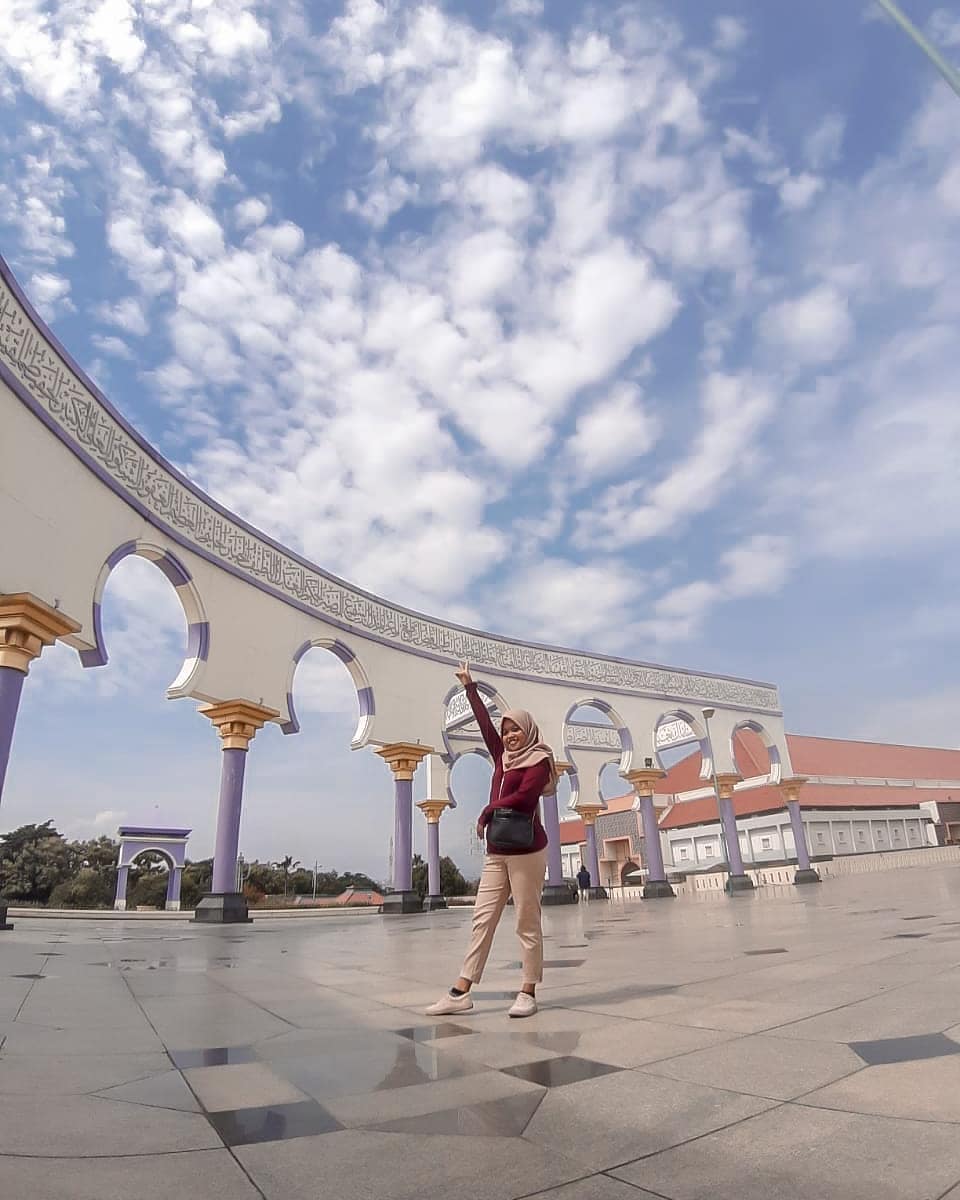
The Roman-style arches look a bit out of place but we kinda dig the eclecticism
Image credit: @ranirunny_
Things get exponentially more interesting with the arches though, inspired by ancient Roman aqueducts that extends from the two buildings to the side. Standing on 25 pillars that represent the 25 prophets of Islam, the arches are carved with various Islamic calligraphic works and is the part of the mosque that stands out the most.
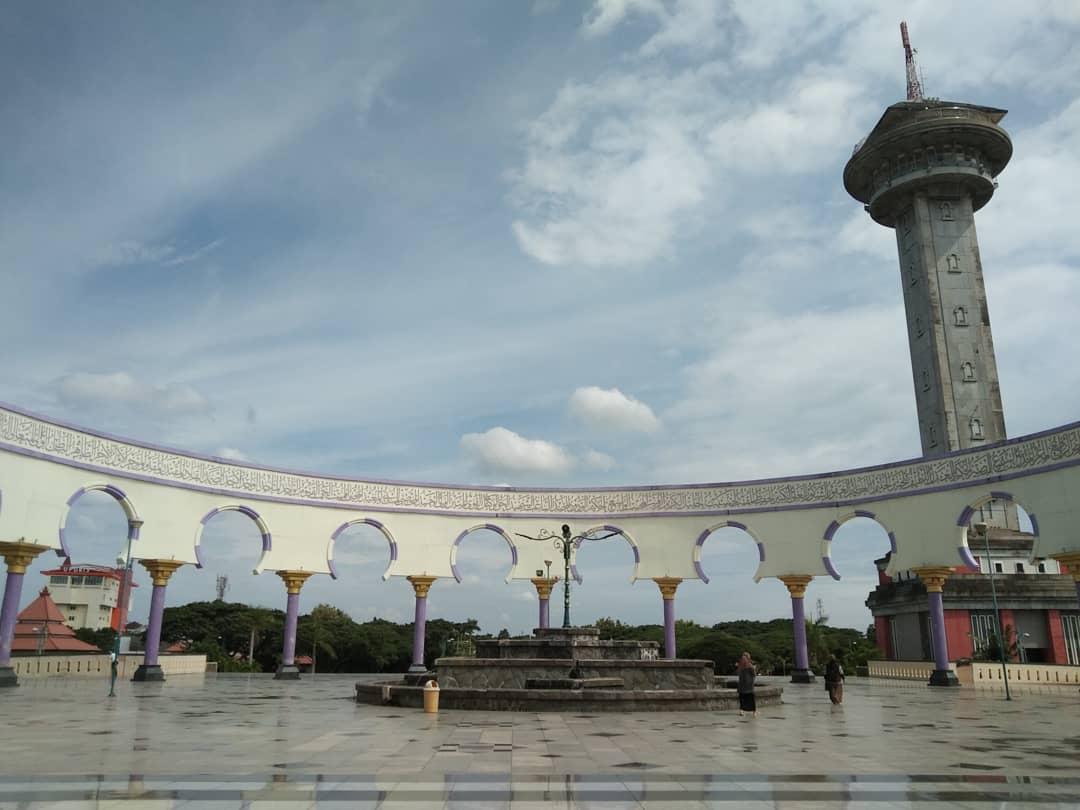
The minaret past the arches has an elevator so you don’t have to worry about your legs getting sore
Image credit: @ardi_kharisma
Once you’re done admiring the wide-ranging architecture styles, we recommend ending your trip by heading up the 99-meter high Asmaul Husna Tower just past the arches. The observation deck at the top and the small, revolving cafe just below is a great place to view the whole mosque and the surrounding city.
Address: Jl. Gajah Raya, Sambirejo, Kec. Gayamsari, Kota Semarang, Jawa Tengah 50166
Opening hours: 4AM-10PM, Daily
Admission fee: Rp. 7,500 (~USD0.53) for entry to the mosque’s tower
3. Muhammad Cheng Hoo Mosque – mosque in the style of a Chinese temple
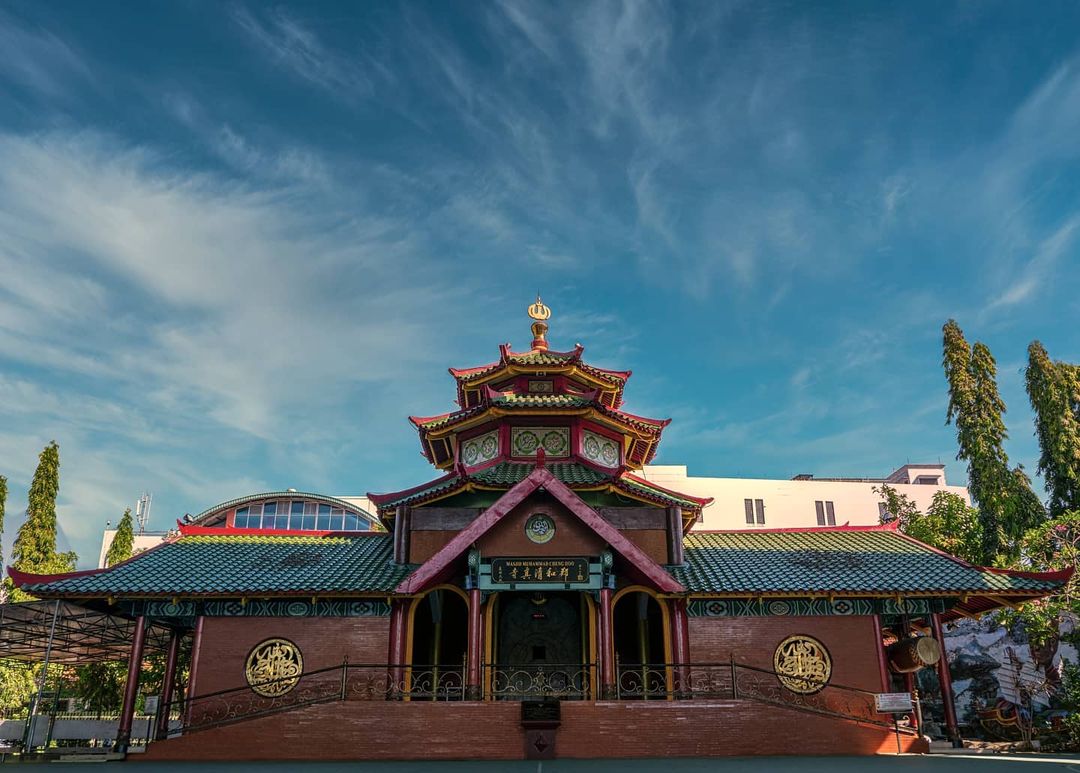
The mosque’s Chinese temple facade is an example of acculturation in Indonesia
Image credit: @paparafa99
As Indonesian kids are often taught in school, the ancient Javanese phrase Bhinneka Tunggal Ika, or “Unity in Diversity”, is the country’s official motto. The Muhammad Cheng Hoo Mosque in Surabaya, built in honor of the Muslim missionary from China, Cheng Ho (or Zheng He), is the embodiment of the country’s commitment to pluralism.
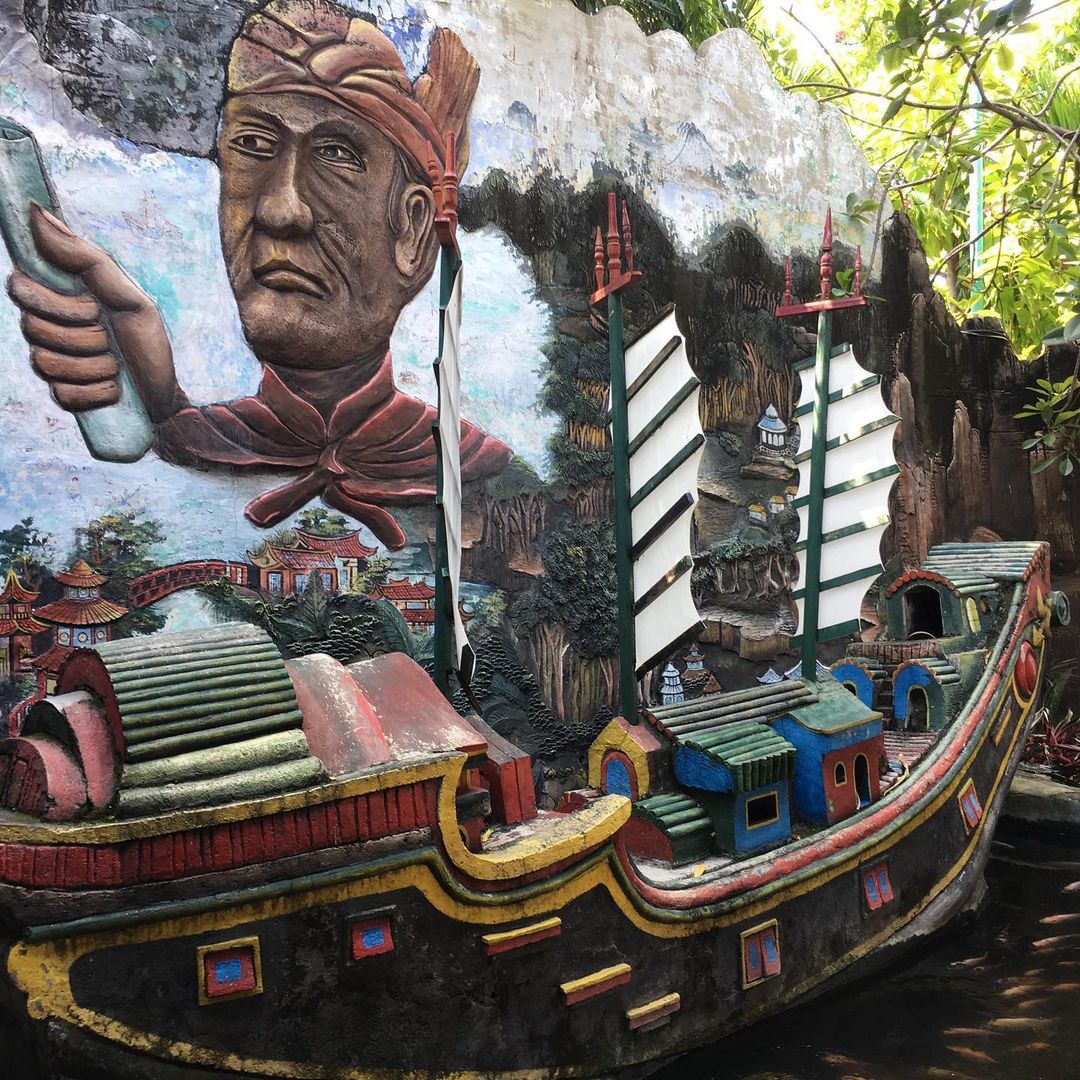
In the back of the mosque is a stone carving of the admiral and the boat he rode to Indonesia
Image credit: @stanleyche2
Designed with a strong Chinese influence, it’s easy to mistake the mosque as a traditional Chinese temple, here known as klenteng, at first glance. The roof is designed after Chinese pagodas and the colors red, yellow, and green, which in Chinese culture represent good fortune and luck, dominate the premises.
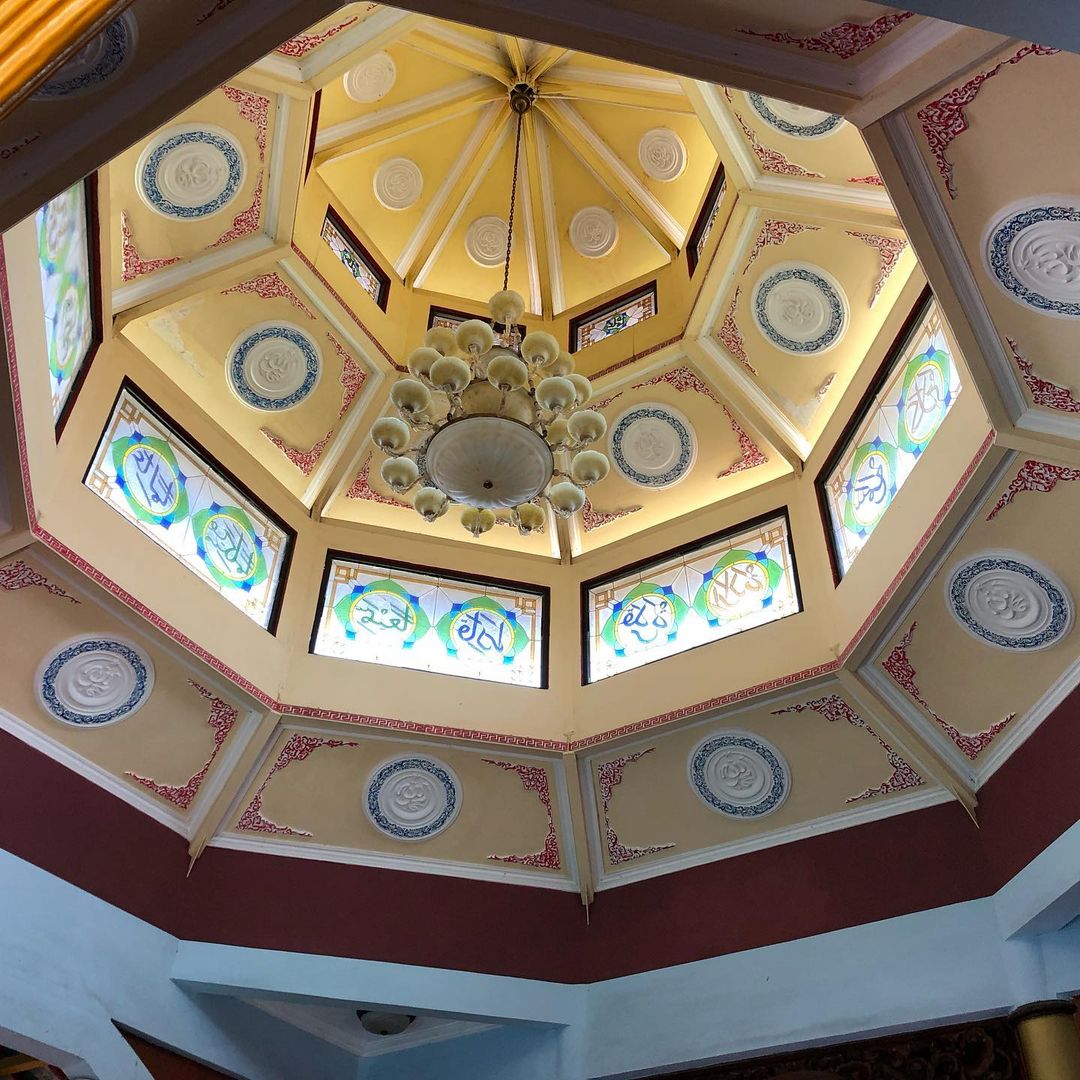
The eight-sided roof is adorned with windows bearing Islamic calligraphy
Image credit: @zulkhairi_ae
Compared to other mosques in this list, the Cheng Hoo Mosque is rather small but still quite a marvel on the inside. The eight-sided ceiling again represents luck and each side is adorned by Islamic calligraphy, proving that it is possible for two distinct cultural identities to coexist peacefully.
The mosque listed here is actually just the first, and the most well-known, in a series of Cheng Hoo Mosques spread across the archipelago. All are built and managed by local chapters of the Chinese Muslim Association of Indonesia, and these mosques in Indonesia represent the cultural diversity that Indonesians are especially proud of.
Address: Jl. Gading No.2, Ketabang, Kec. Genteng, Kota SBY, Jawa Timur 60272
Opening Hours: 4AM-11PM, Daily
4. Menara Kudus Mosque – 16th-century mosque designed after a Hindu temple
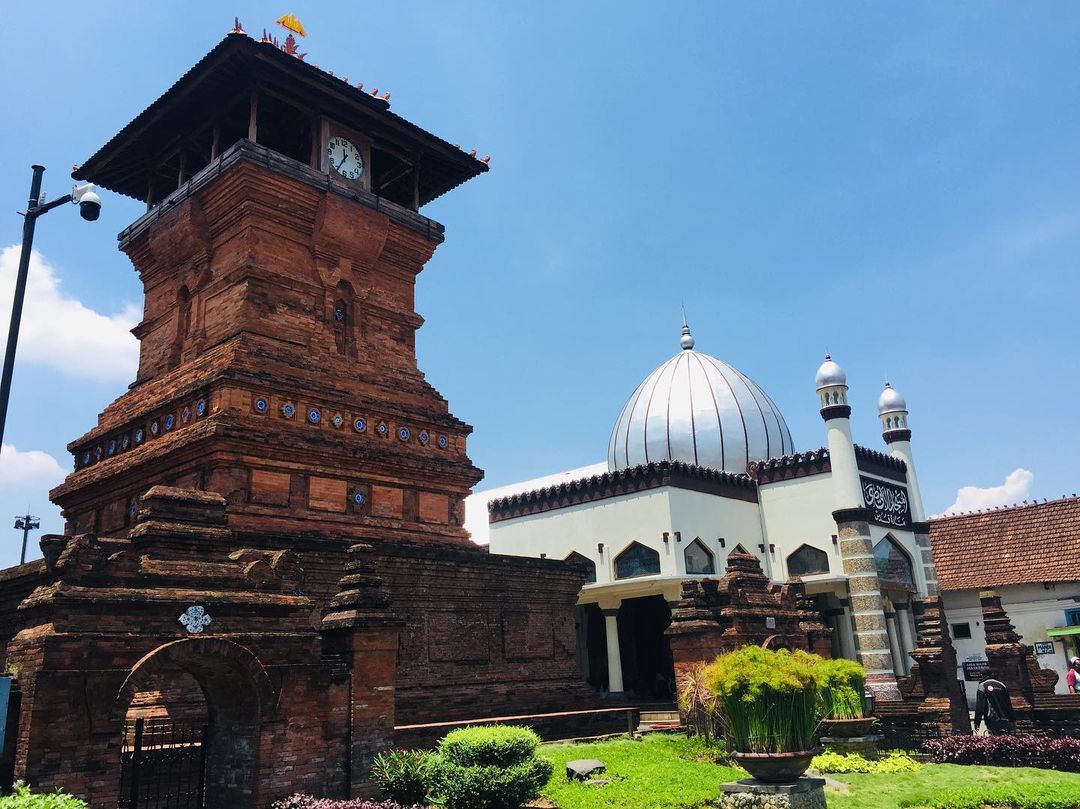
The mosque’s tower is modeled after a Hindu temple, which stands in contrast to the conventional mosque building
Image credit: @mmoe.06
With a mix of Hindu and Islamic architecture, the historic Menara Kudus Mosque is another prominent example of Indonesia’s interfaith harmony. The Hindu-inspired architecture is particularly visible within the mosque’s tower and namesake, Menara Kudus, which heavily resembles a traditional Hindu candi, such as the famous Prambanan Temple in Yogyakarta.
The mosque was built in 1549 by Sunan Kudus, one of the 9 saints of Wali Songo, a group of clerics who were instrumental in spreading the teachings of Islam in Indonesia. The Kudus regency and the mosque itself is named after the late saint and as his final resting place, many Muslims journey to the mosque as part of their pilgrimages.
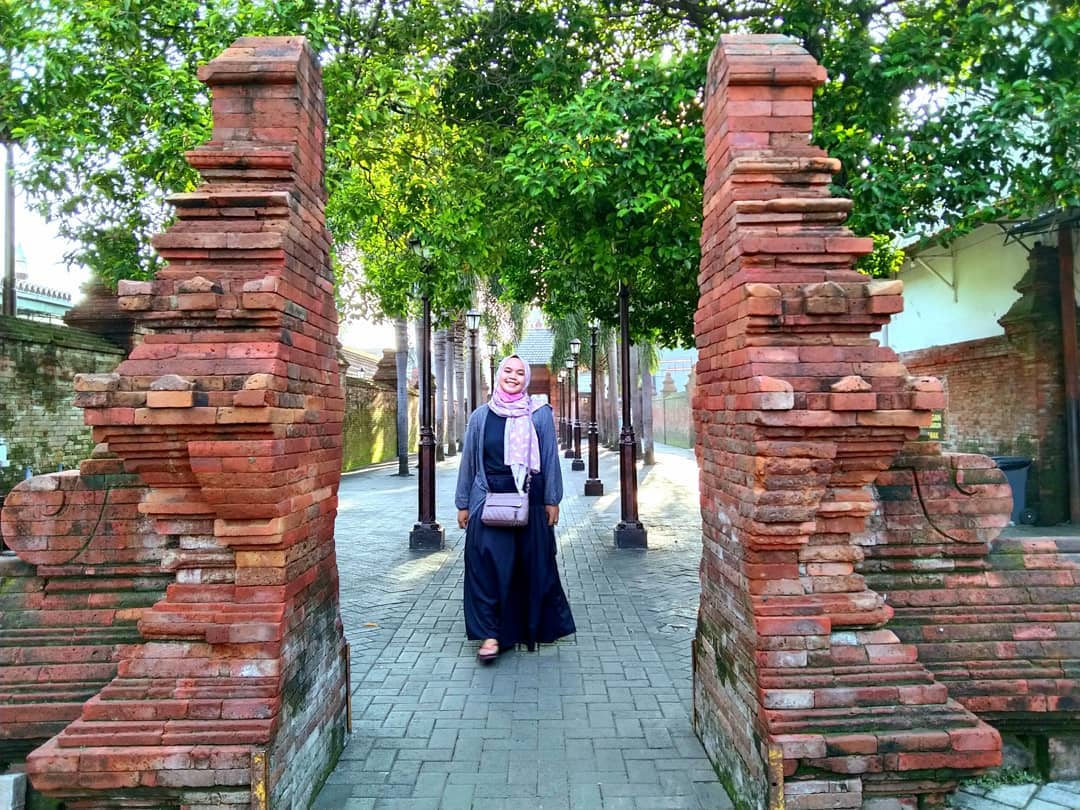
With several split gateways inside, the complex has a strong Balinese temple vibe
Image credit: @irsyandhipa
At the time, the influence of Hinduism still runs pretty strong in Indonesia and that is reflected in the design of the mosque. Red bricks and split gateways abound here and if it wasn’t for the main mosque building, the complex could easily be mistaken for a Balinese temple.
Address: Jl. Menara, Pejaten, Kauman, Kec. Kota Kudus, Kabupaten Kudus, Jawa Tengah 59315
Opening hours: 24 hours, Daily
5. Amirul Mukminin Mosque – gorgeous ‘floating’ mosque on a seaside promenade
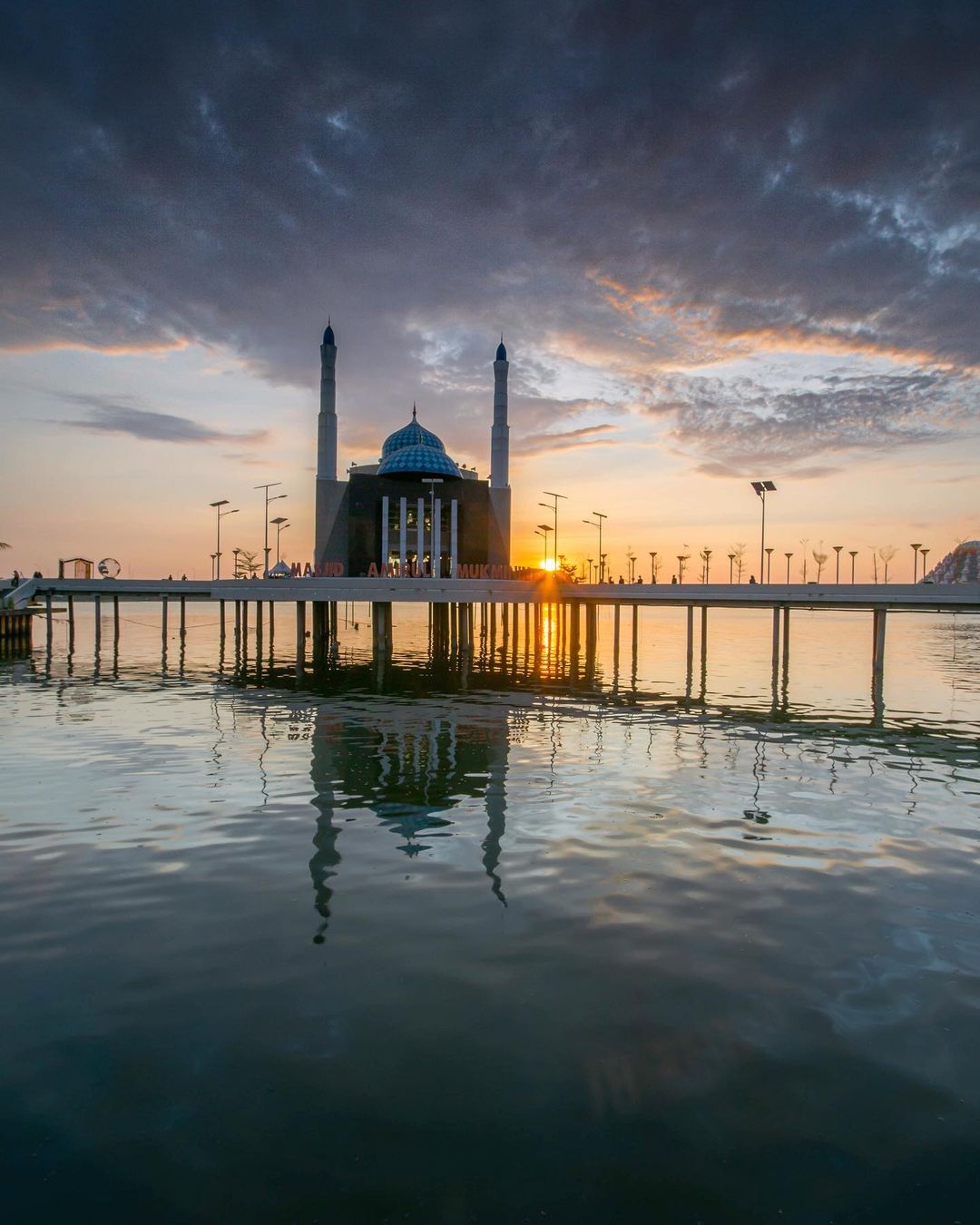
At sunset, the mosque is at its most breathtaking, drawing hordes of amateur shutterbugs to the area
Image credit: @ryos_youngkrex
Perched just off the coast of the Losari Beach in Makassar, the Amirul Mukminin Mosque earned its moniker because of its unique location. The design evokes the traditional elevated house of the Bugis people of South Sulawesi and the ‘floating’ mosque is connected to the promenade through a pair of bridges on either side.
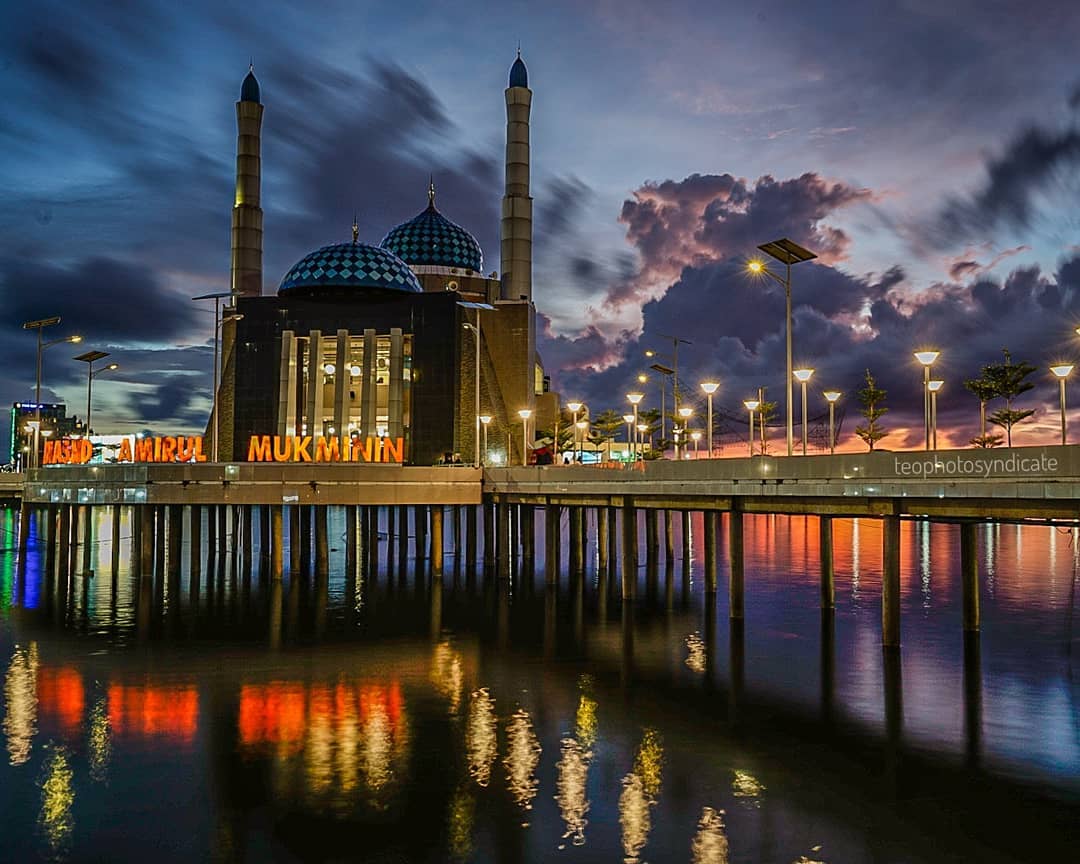
At night, the water reflects the surrounding night lights and the view is just as gorgeous
Image credit: @teukuoki
We highly recommend going there just before sunset as the image of the twin blue dome of the mosque next to the setting sun is quite a sight. But if you’re not pressed for time, we recommend staying until the evening, especially if you’re with your significant other as the seaside promenade is a popular place for date nights.
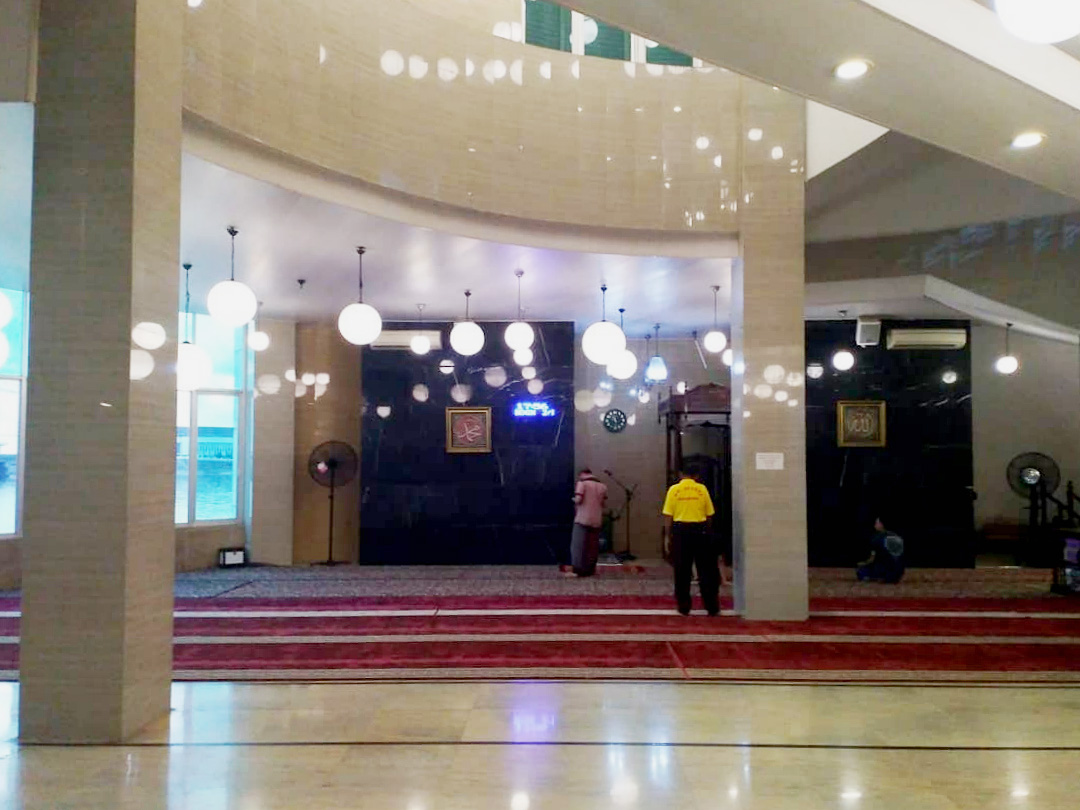
While the interior is far more modest, the hanging lights are a pretty nice touch
Image adapted from: @teguh.kurniaputra
Past sunset, the surrounding bridges also light up and your romantic nighttime walk along the promenade won’t be complete without passing by the mosque at least once. The evening is also when the mosque’s interior hanging lights kick in, and Muslims should at least spare a moment to do their evening prayer on the premises.
Across the water, you’ll no doubt spot the curious silhouette of the 99 Domes Mosque, which as of writing, is still in the final stages of construction. That mosque is part of the planned Center Point of Indonesia project, a Garuda-shaped reclaimed island that is being touted as Makassar’s newest lifestyle hub.
Address: Jalan Penghibur No.289, Losari, Ujung Pandang, Kota Makassar, Sulawesi Selatan 90112
Opening hours: 24 hours, Daily
6. Tubaba Mosque – unconventional mosque by a giant fish pond
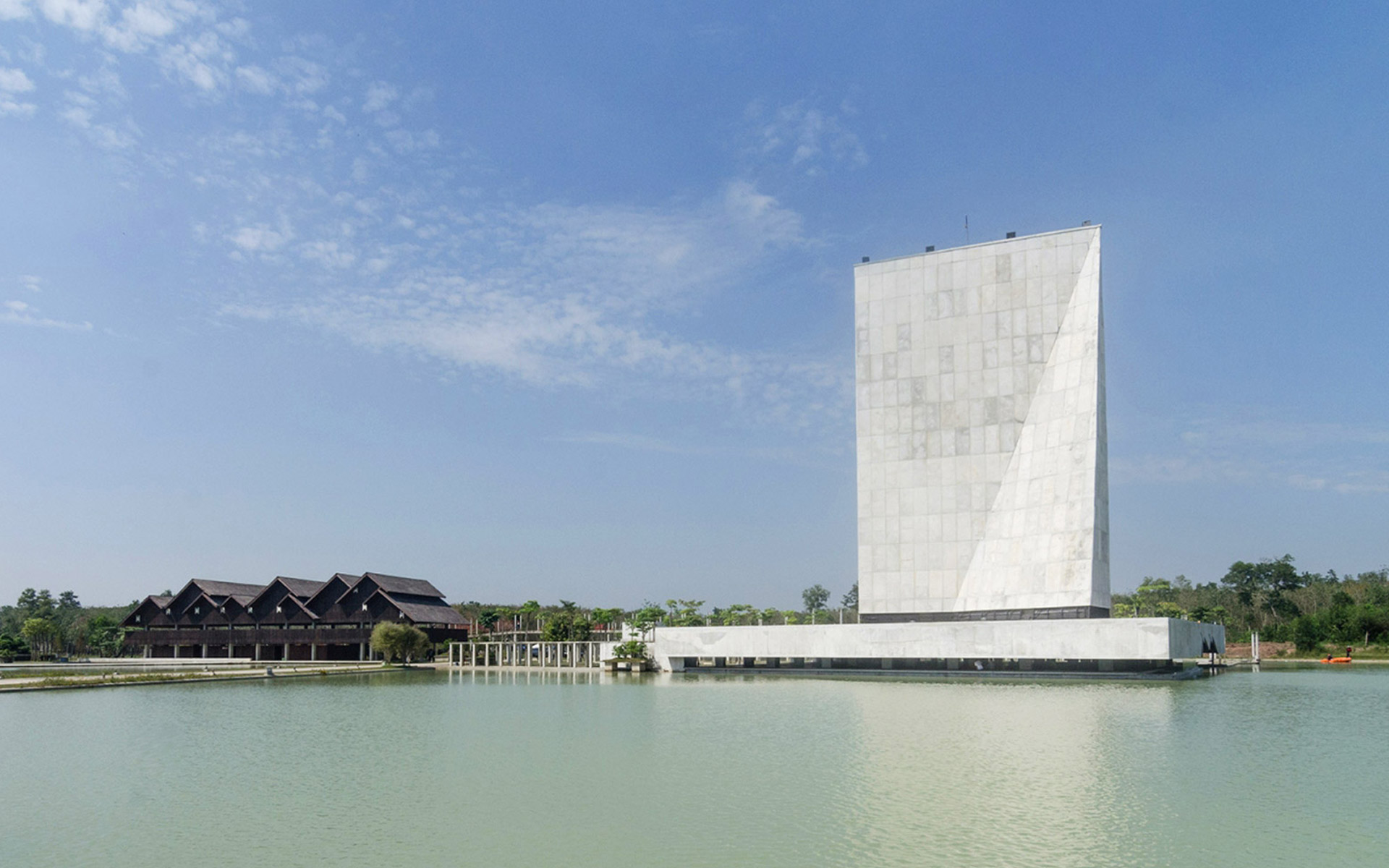
The design of the Tubaba Mosque at the right with no dome and minaret is fascinatingly progressive
Image credit: Andra Matin
Designed by famed Indonesian architect Andra Matin, the Tubaba Mosque in the Tulang Bawang Barat (Tubaba) Islamic Center, Lampung adopts a highly unconventional design. There’s no tower, there’s no dome, the exposed concrete looks a bit uninviting, and there’s absolutely nothing to indicate that the building is actually a mosque at first glance.
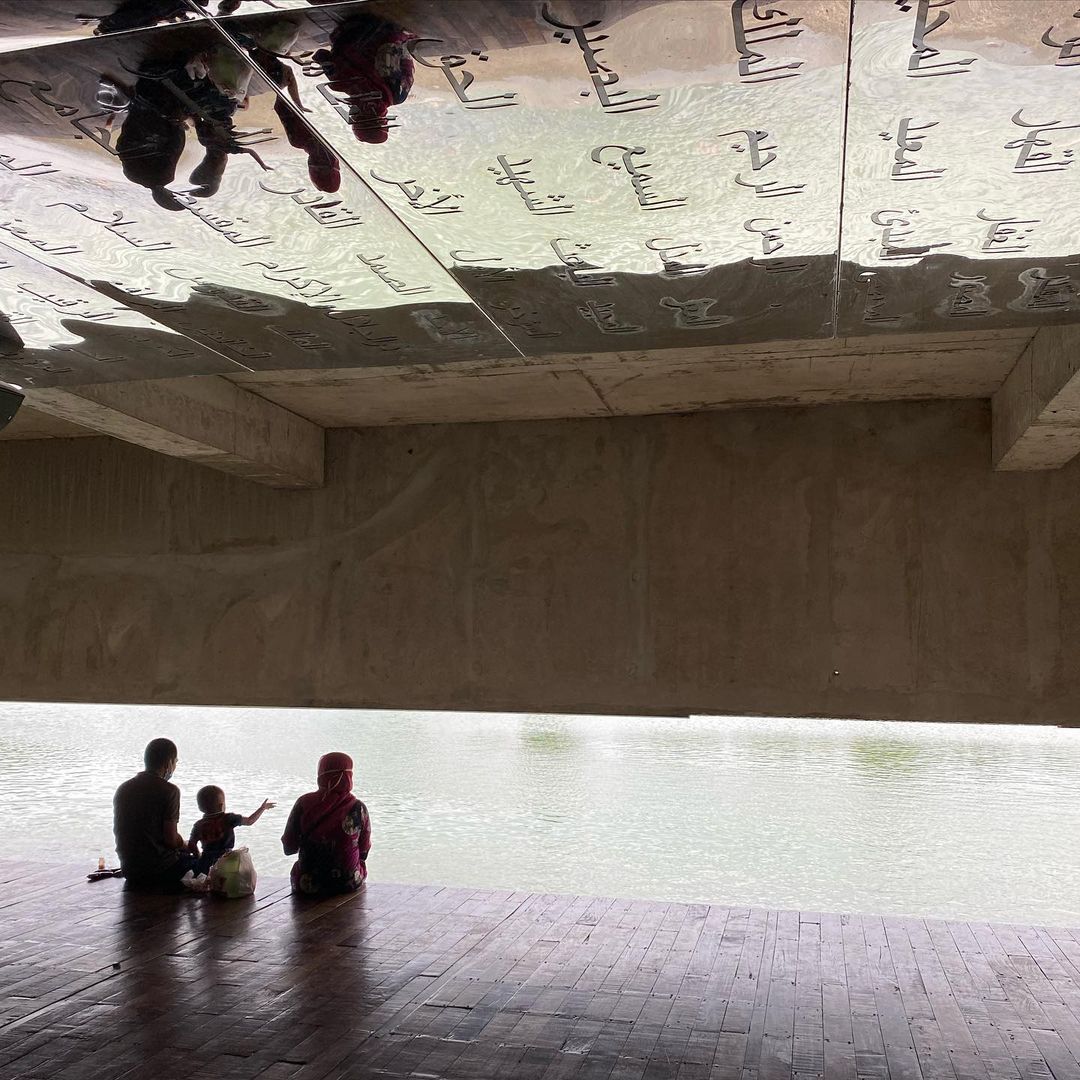
The mosque borders the pond and you can make out the Islamic calligraphy carved into the ceiling
Image credit: @ferryridwan
Inside, it’s a different story, as the hardwood floor, open air design, and the cool air from the next door pond melds into one comfortable, serene space, ideal for worshippers. Once you’re done praying, take time to cool off by the pond where you can actually see and feed the fishes living in the complex.
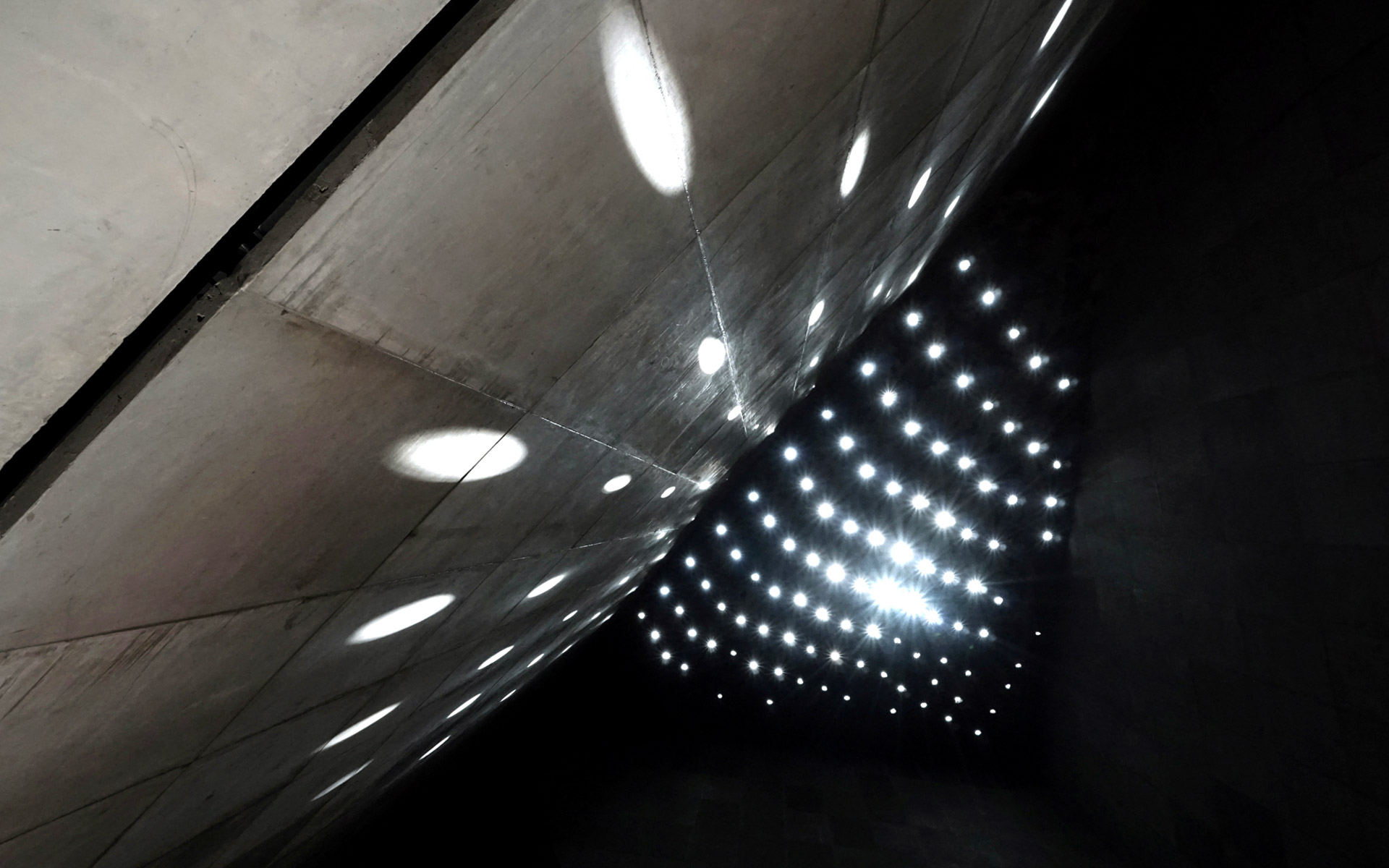
The 99 light openings at the top of the mosque represent the 99 Names of God in Islam
Image credit: Andra Matin
The high, 30-meter ceiling in particular is quite a sight, with 99 openings at the top that, when the sun is just at the right angle, project light onto the hardwood floor. The number of the opening itself represents the 99 Names of God, which are also carved into the lower ceiling of the mosque.
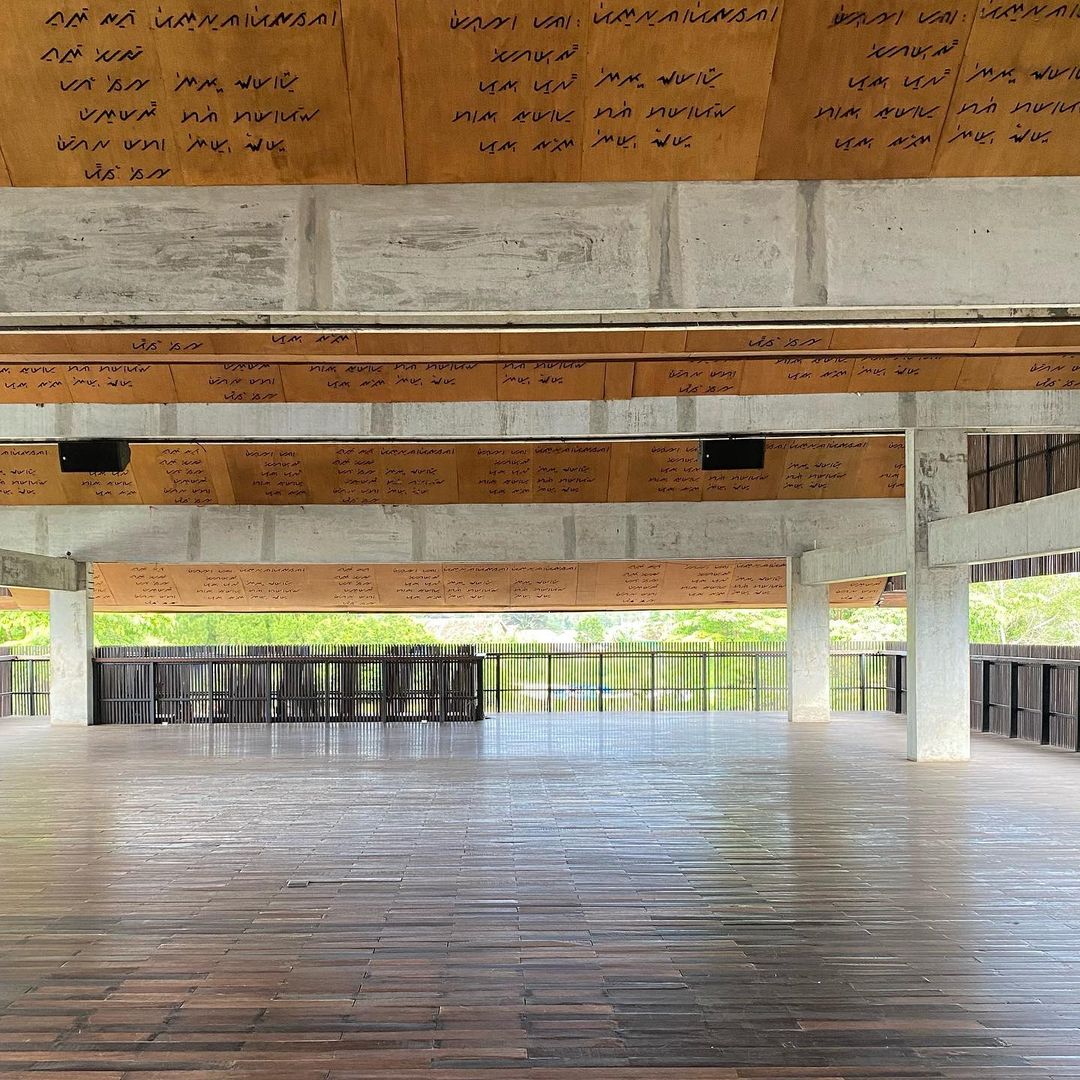
The ceiling of the Sessat Agung community center next door is carved with traditional Lampung script
Image credit: @ferryridwan
With the Tubaba region located a bit out of the way, we highly recommend you fully explore the gorgeous Islamic center before you head back. Right next to the mosque is another one of Matin’s designs, the Sessat Agung community center, that’s just as worthy of a visit, especially for architecture buffs.
Address: Jl. Raya Panaragan Jaya – Pulung Kencana, Panaragan Jaya, Tulang Bawang Tengah, Kab. Tulang Bawang Barat, Lampung 34693
Opening hours: 24 hours, Daily
7. Al-Irsyad Mosque – cubic mosque in the shape of the Kaaba
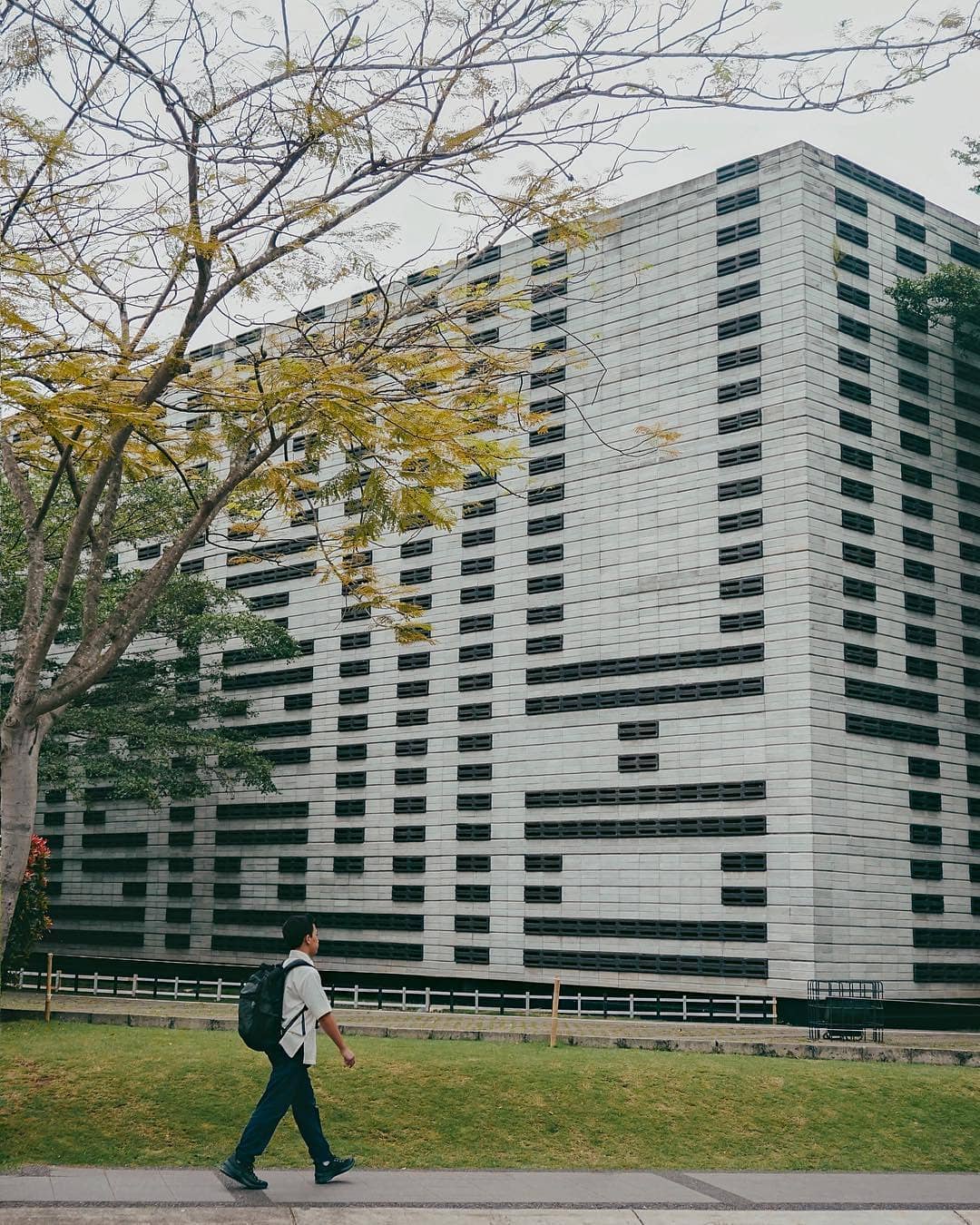
The gaps in the rectangular facade seem random, but when viewed from afar, spell the Shahada
Image credit: @bandung.juara
Designed by another famed Indonesian architect Ridwan Kamil, the current governor of West Java, the Al-Irsyad Mosque also forgoes the traditional mosque-with-a-dome design. It is instead designed in the shape of the Kaaba in Mecca using a series of stacked, rectangular stones.
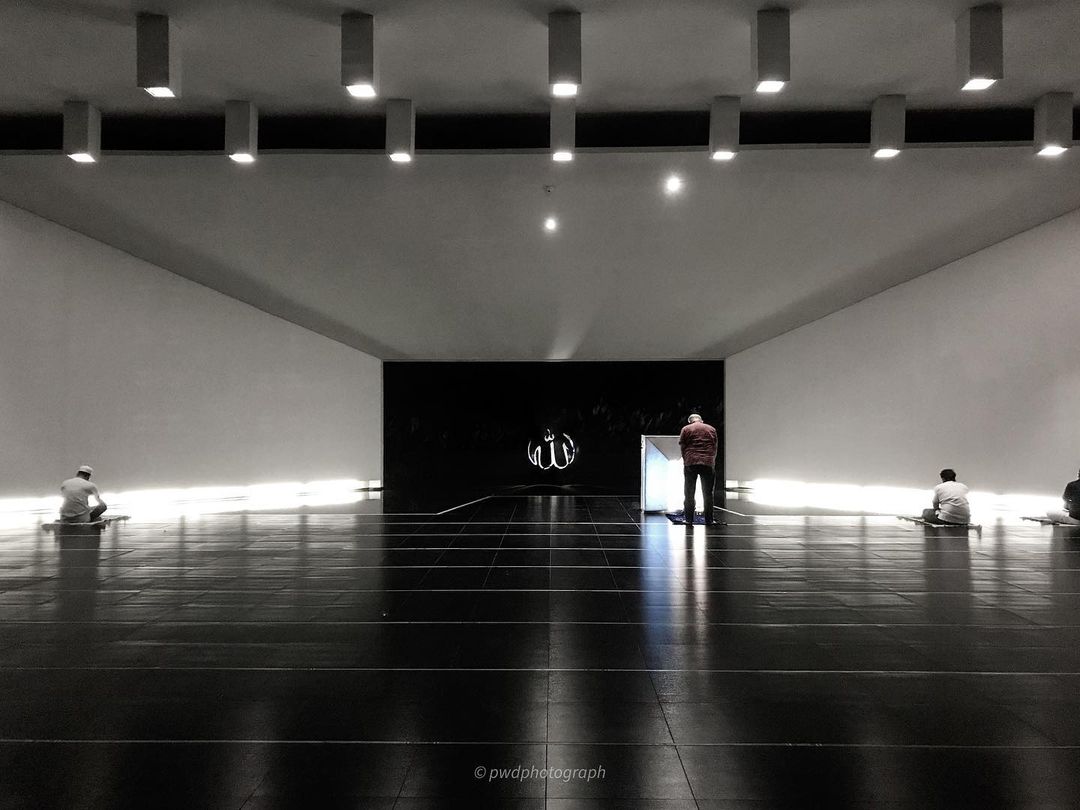
The Allah inscription illuminates at night so that Muslims never lose sight of God
Image credit: @pwdphotograph
These stones aren’t uniform, creating gaps in the wall that when seen from afar spells the Shahada, an Islamic creed that makes up the first of the Five Pillars of Islam. Located in Kota Baru Parahyangan, an in-development township west of Bandung, these gaps also let in some of the area’s famous chilly air for worshippers to enjoy.
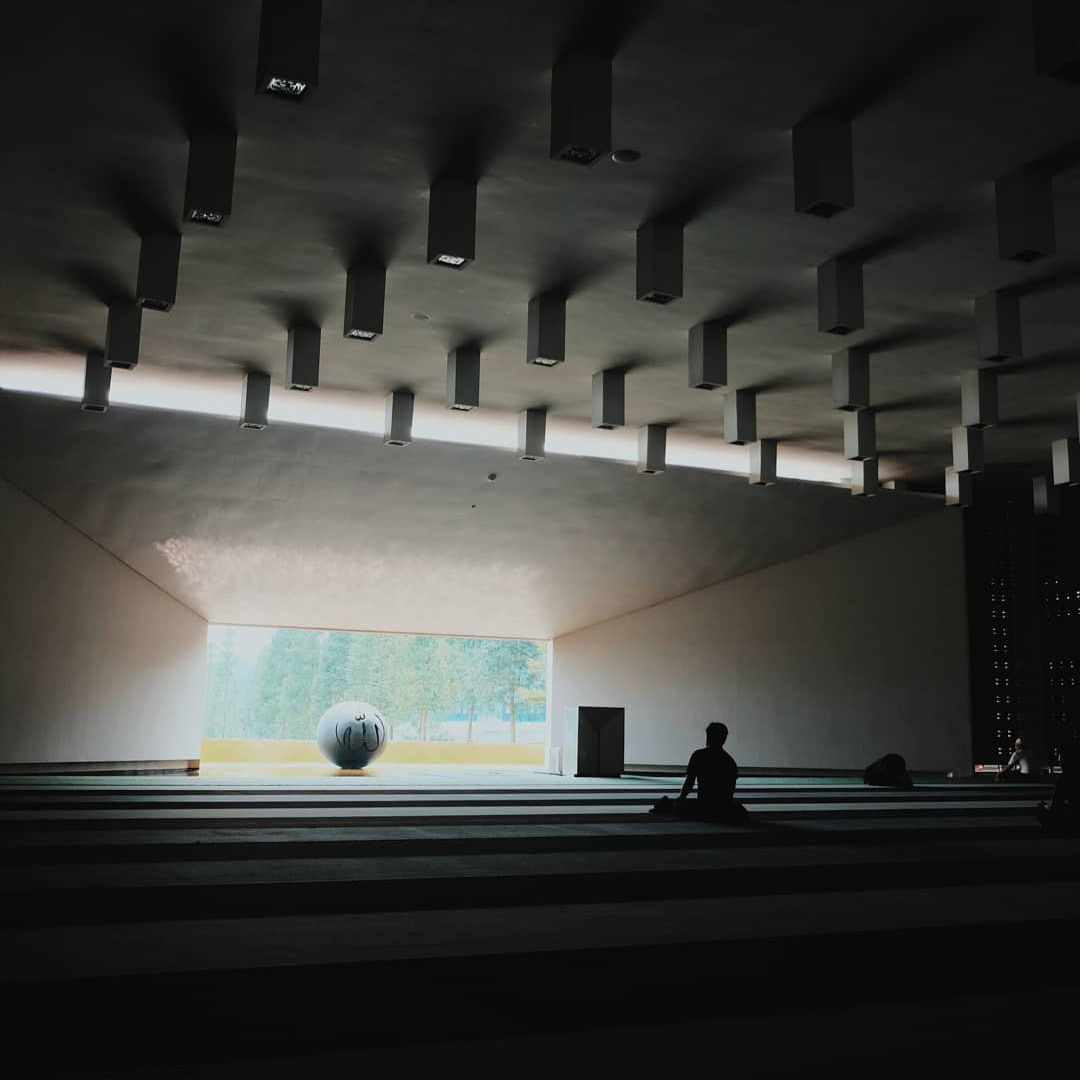
The unique mihrab and the lack of a qibla wall are hands down our favorite aspects of the mosque
Image credit: @lukiiiiluk
One design touch that we simply can’t get enough of is the mosque’s lack of a traditional mihrab that most mosques in Indonesia feature. Rather, the imam, the one that leads the congregation during prayers, is surrounded by a small pond that opens out to nature outside while directly facing a round-shaped stone carved with the name of God, Allah.
Address: Jl. Parahyangan KM. 2,7, Kota Baru Parahyangan, Cipeundeuy, Padalarang, Kabupaten Bandung Barat, Jawa Barat 40553
Opening hours: 24 hours, Daily
8. Baitul Muttaqin Mosque – opulent mosque with a dome inspired by the Hagia Sophia
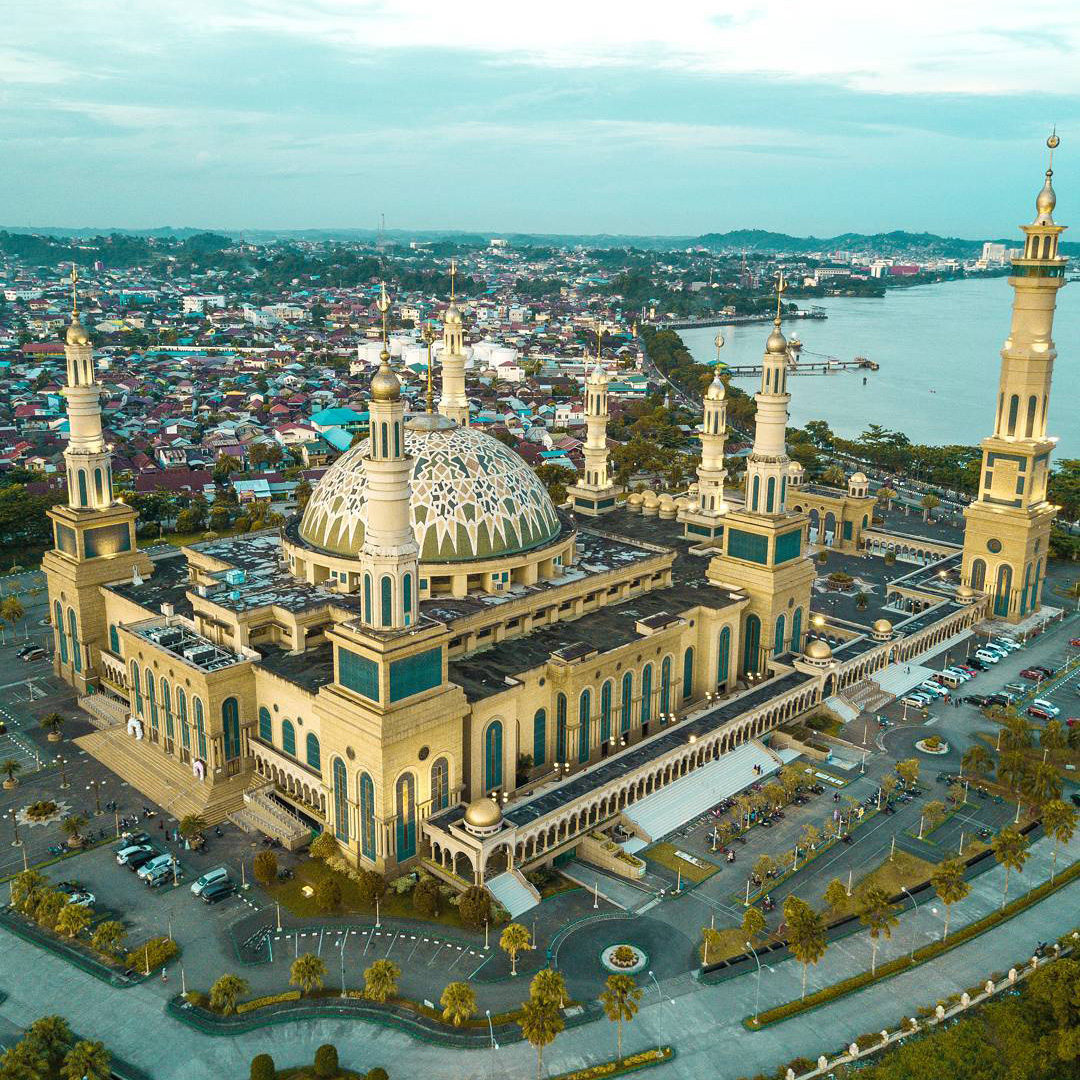
Aerial view of the majestic Baitul Muttaqin Mosque by the Mahakam River
Image credit: @mas_denyyy
While the official name of the mosque is the Baitul Muttaqin Mosque, it’s more popularly known as Samarinda Islamic Center Mosque. Sitting by the Mahakam River in the city of Samarinda, East Kalimantan, the opulent building takes inspiration from some of the world’s most famous mosques plus a dash of local culture.
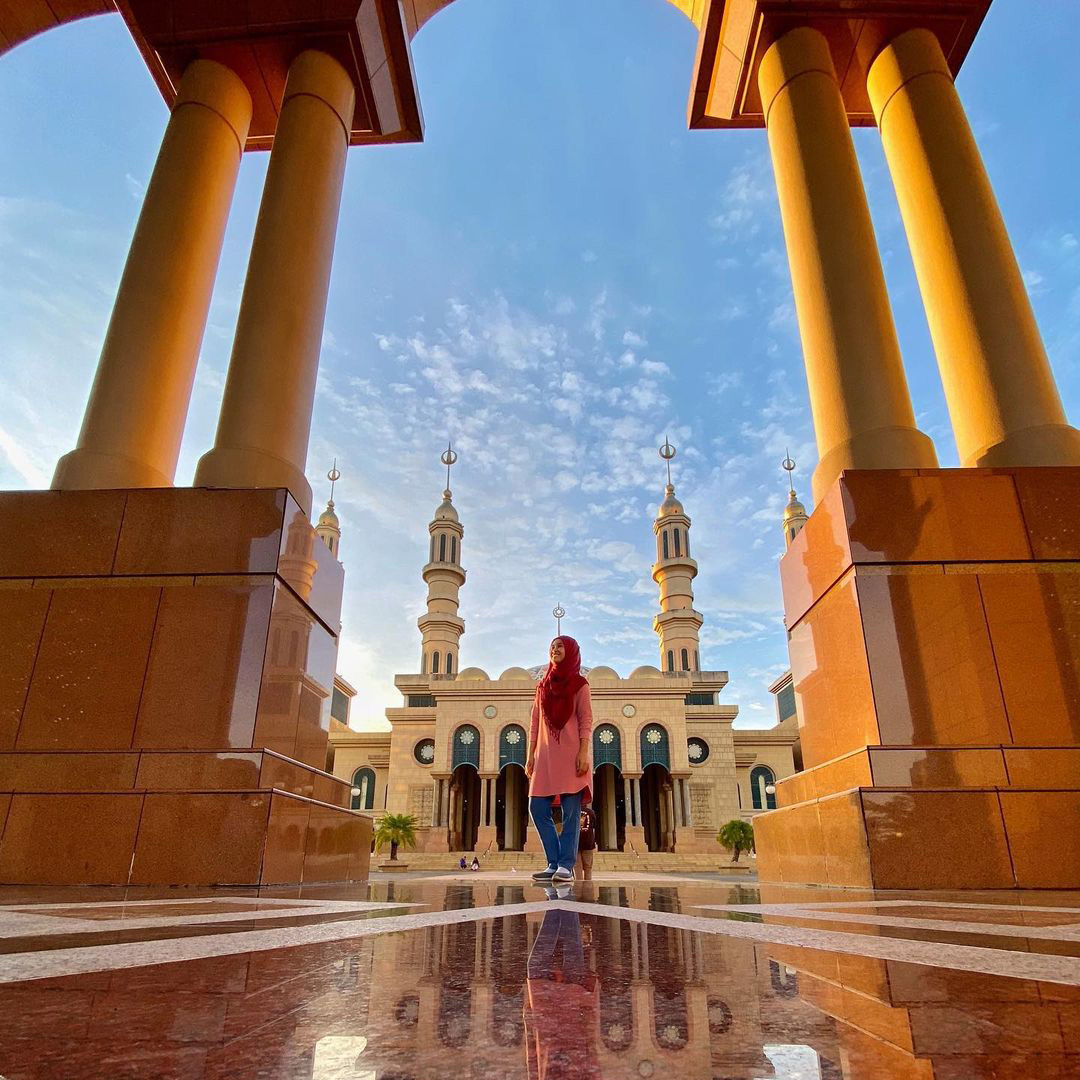
Starting from the front gate, the mosque’s stunning architecture is a haven for great photos
Image credit: @ekaczain
The extravagant main dome is inspired by Turkey’s famous Hagia Sophia while the mosque’s seven towers, known as minarets, take after those of Medina’s Masjid Al-Nabawi. If you feel like the gate and overall structure reminds you of the Putra Mosque in Putrajaya, Malaysia, that too is more than a coincidence.
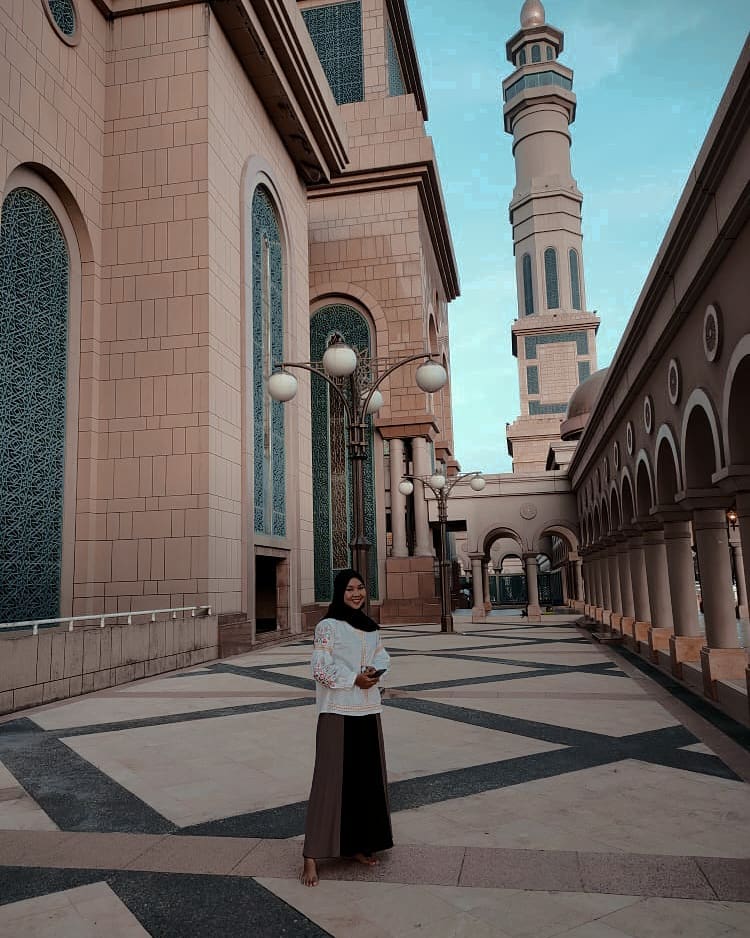
Walk around the main mosque building and you’ll feel as if you’re no longer in Indonesia
Image credit: @nur_aisyah_darwis
The main tower itself is 99 meters high, representing the 99 Names of God, and provides a great spot to see the whole complex and the surrounding city and river. Of particular interest is the dome, adorned by motifs inspired by the Dayak people, one of the native tribes of Kalimantan.
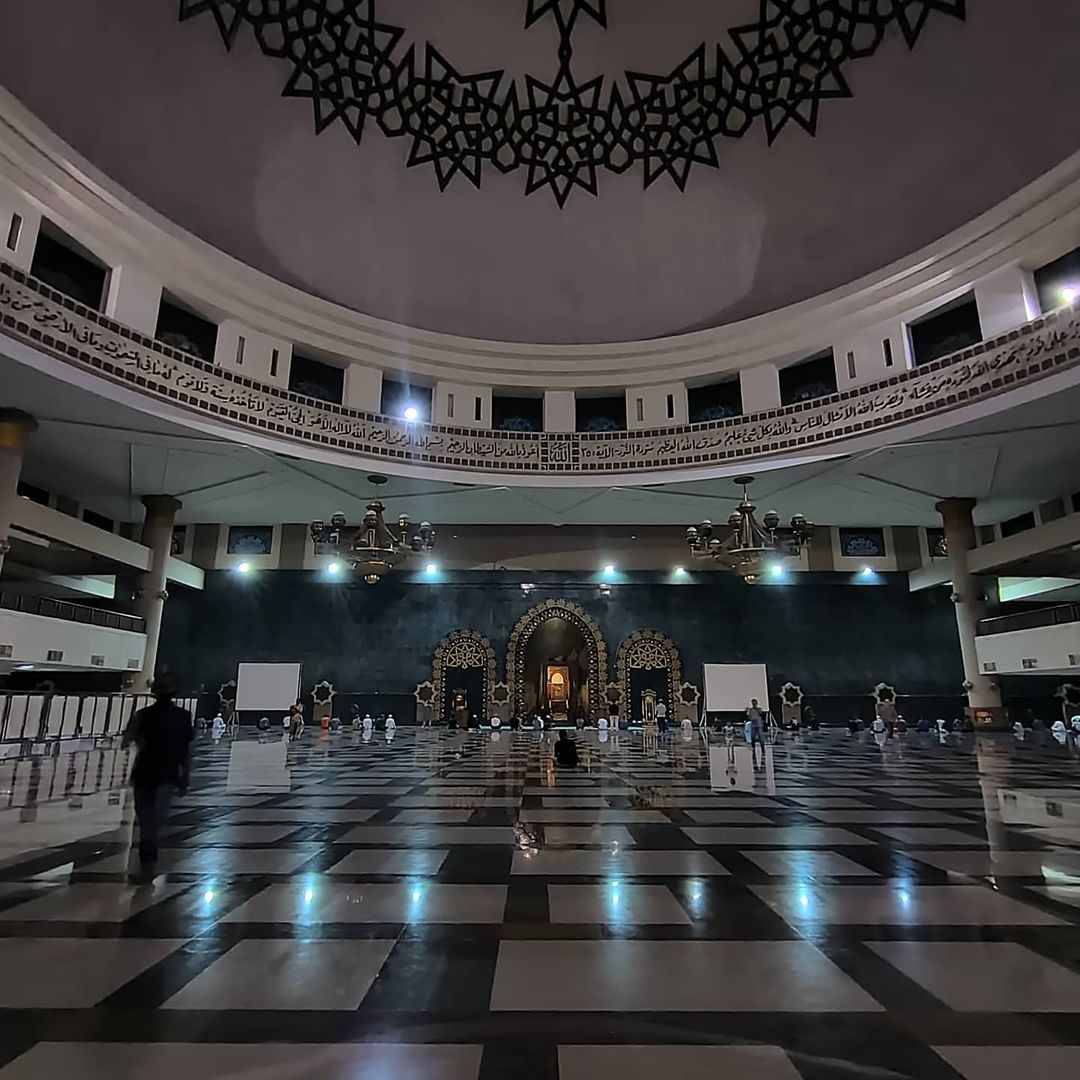
The chandeliers and the dome of the main praying hall gives the mosque a grand vibe
Image credit: @alamsyah_dt23
While it is one of the biggest mosques in Indonesia and in Southeast Asia, we don’t consider the mosque opulent simply because of its size. The towering pillars at the entrance and the chandeliers hanging above the main praying area, befitting of the ancient Ottoman Empire, are the main reasons why.
Address: Jl. Slamet Riyadi No.1, Karang Asam Ulu, Kec. Sungai Kunjang, Kota Samarinda, Kalimantan Timur 75126
Opening hours: 24 hours, Daily
9. Istiqlal Mosque – Southeast Asia’s biggest mosque with a modern, brutalist design
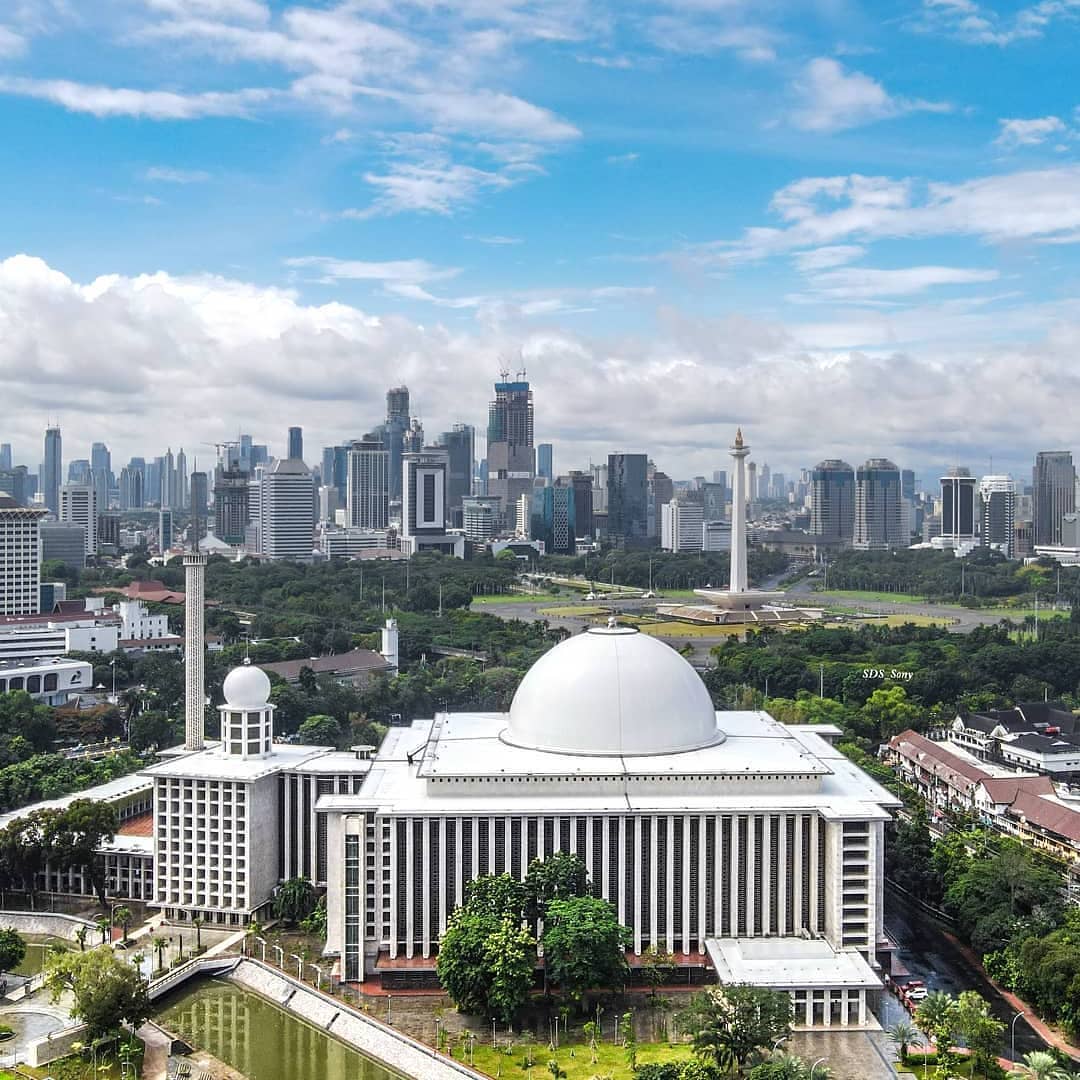
Aerial view of the Istiqlal Mosque with the National Monument visible in the background
Image credit: @sds_sony
Located a stone’s throw away from the National Monument in Jakarta, the grand Istiqlal Mosque is officially designated as the country’s national mosque. First opened in 1978, the Istiqlal Mosque remains Southeast Asia’s biggest mosque to date, capable of accommodating 200,000 worshippers within the whole complex.
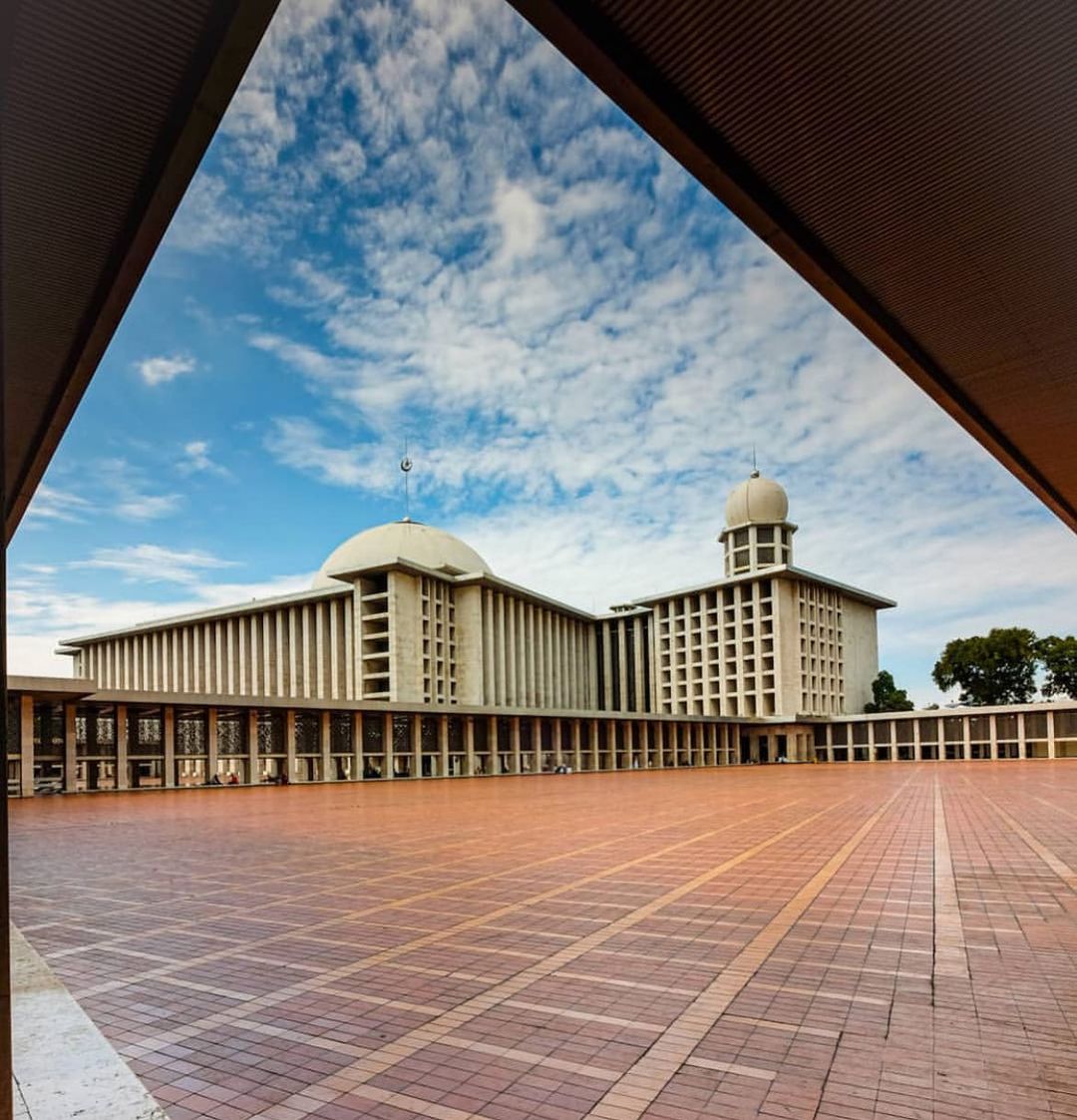
The mosque’s geometric pattern, an example of modern, brutalist architecture, has become its most defining feature
Image credit: @vlss09
Other than the size, the mosque’s trademark geometric ornamentation, a classic example of modern brutalism, is what makes it worth a visit especially if you have an interest in architecture. Every now and then, architecture and art students can be found around the area trying to capture the mosque’s unique yet understated design in sketches.
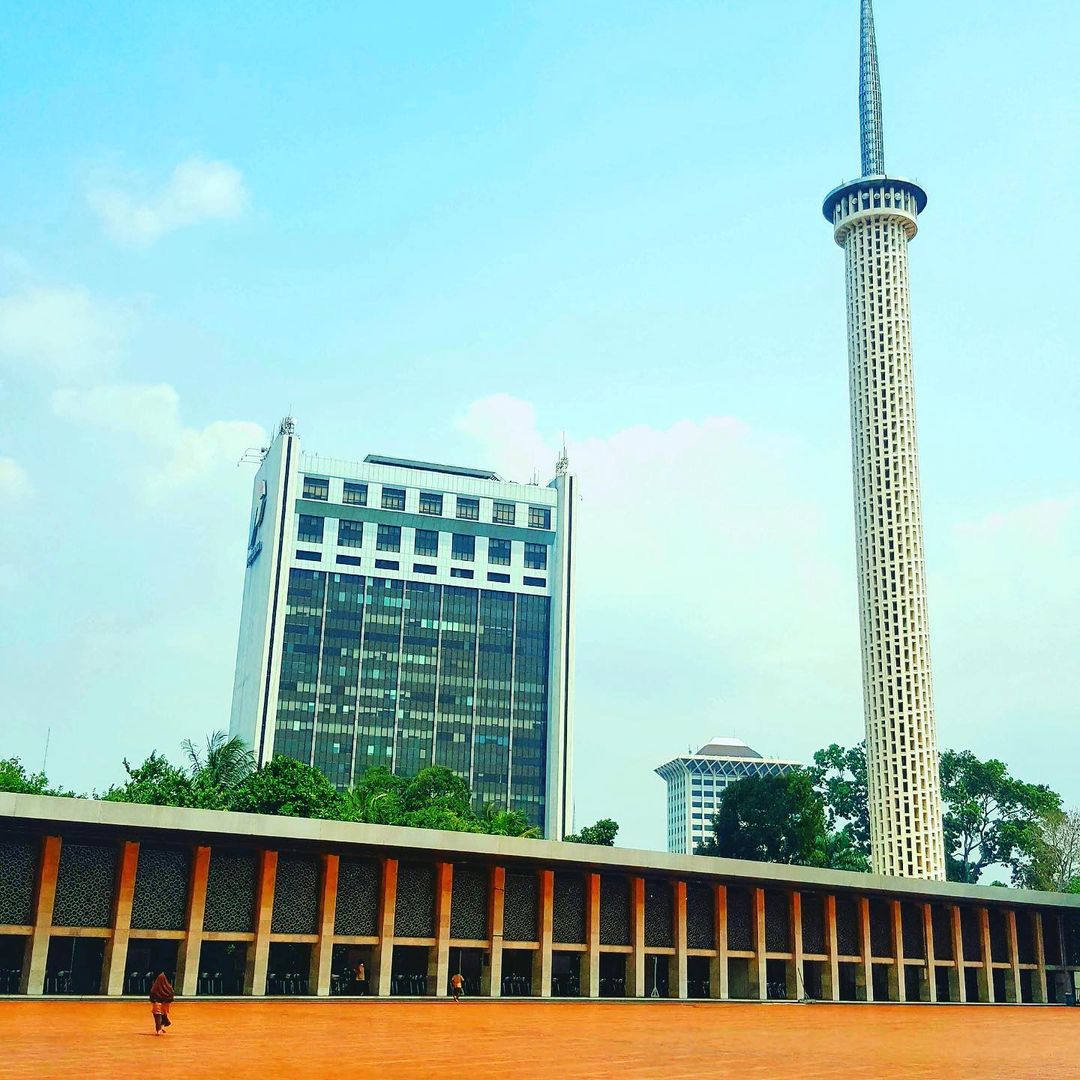
The sole minaret continues the mosque’s understated design
Image credit: @musashiuchiwa
If you want to get up close and personal, we recommend heading out to the mosque’s inner courtyard. From there, you can intimately appreciate the mosque’s geometric pattern on one side and gawk at the sole minaret tower on the other side.
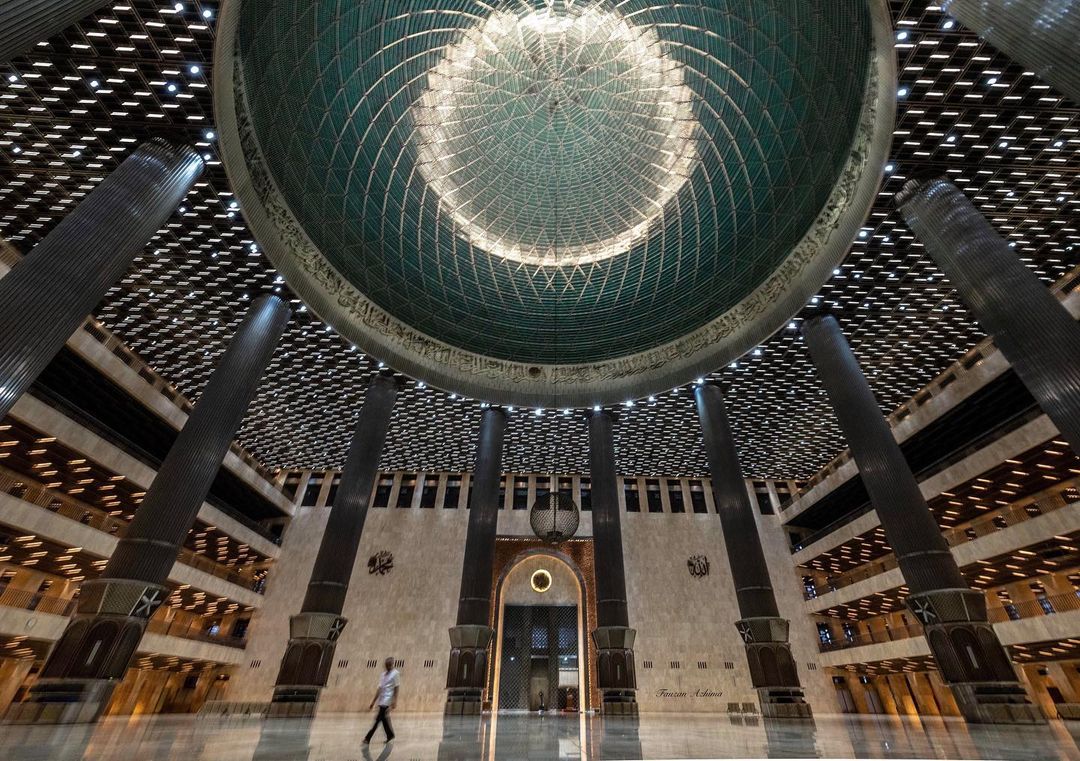
The mosque’s interior and the magnificent dome. Note the Islamic calligraphy running around the bottom of the dome
Image credit: @ojanovic
For a truly humbling experience, though, you’d want to head inside the main building. Even after repeated visits, looking up at the inside of the main 45-diameter dome, the number representing 1945, Indonesia’s year of independence, will never fail to elicit gasps of wonder.
Despite being still actively used for prayers, we like how Istiqlal still went out of their way to accommodate tourists. After signing the guest book, visitors have the option to enjoy a tour of the premises with an English-speaking guide that will provide background information on the history of Istiqlal and Islam in general.
Entrance is free, like for most mosques in Indonesia, but note that if you participate in the tour, tips for guides are mandatory.
Address: Jl. Taman Wijaya Kusuma, Ps. Baru, Kecamatan Sawah Besar, Kota Jakarta Pusat, Daerah Khusus Ibukota Jakarta 10710
Opening hours: 24 hours, Daily
10. Baiturrahman Grand Mosque – Dutch colonial architecture meets Mughal architecture
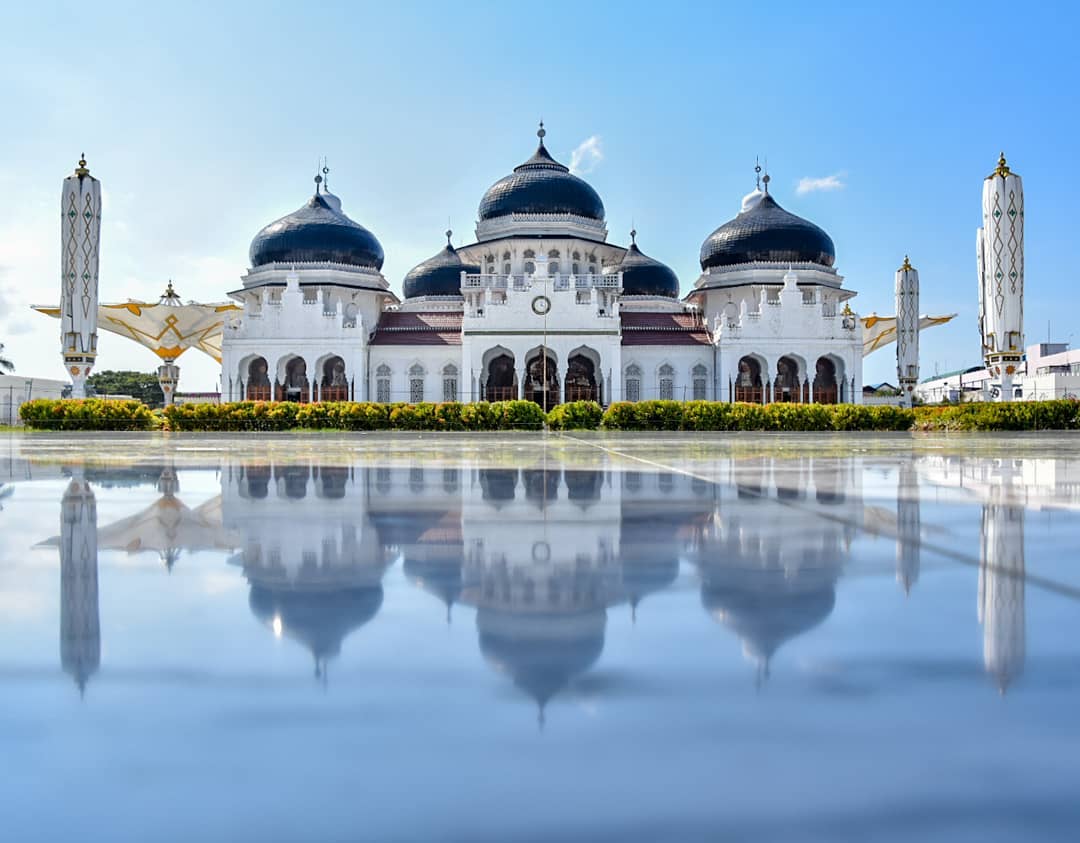
The main building of the mosque still uses the original design from the Dutch colonial era
Image credit: @miry_giramondo
The pride of Aceh, the Baiturrahman Grand Mosque’s trademark looks are equalled only by its storied history. Originally built in 1881 by Dutch colonials with inspiration from Mughal architecture, the pristine white walls and black domes remain as the mosque’s defining features even after more than a century.
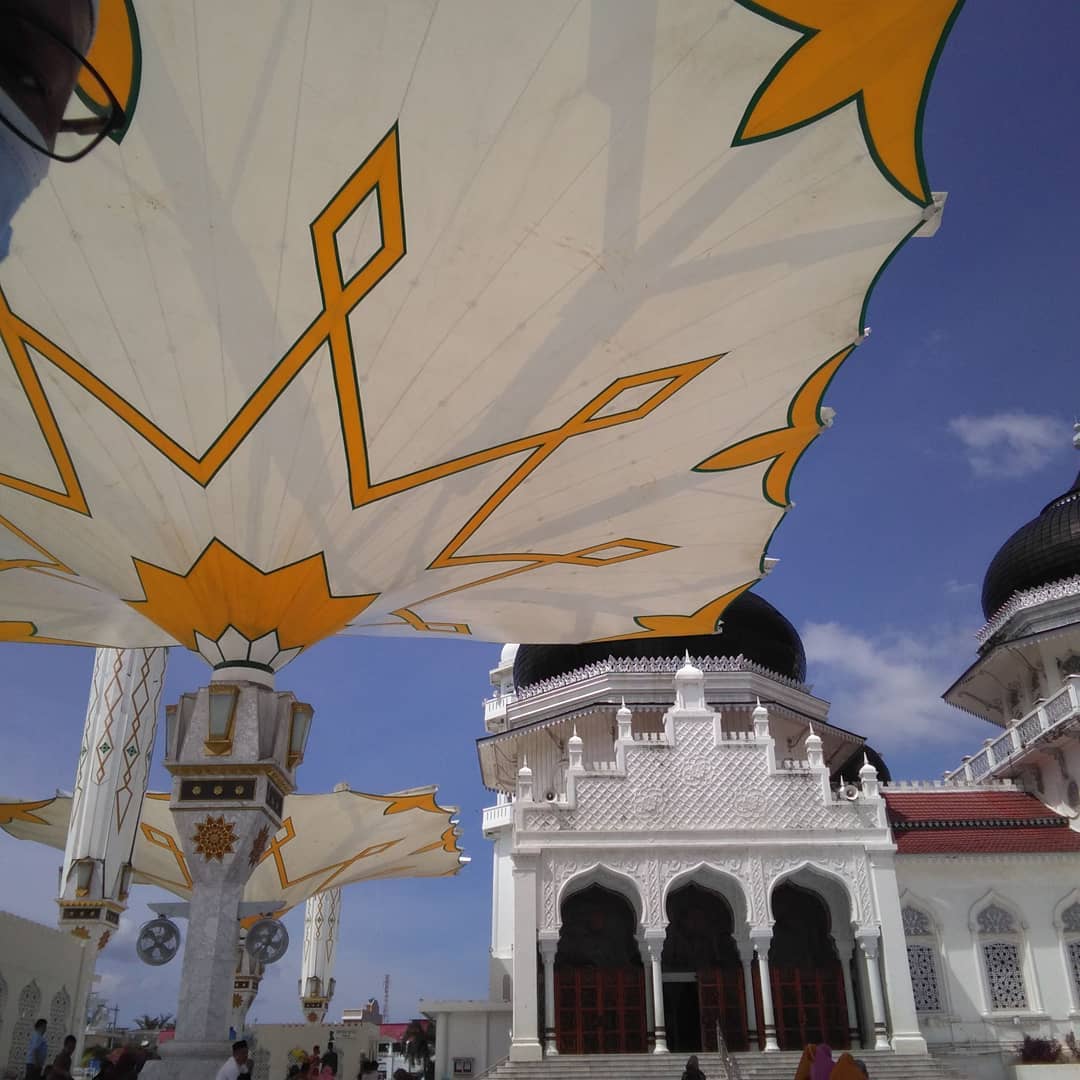
The umbrellas on the other hand, are a later, and much welcomed, addition
Image credit: @risa2890
The rest aren’t part of the original design but we love the mosque’s marble courtyard and giant umbrellas, reminiscent of the Masjid Al-Nabawi in Medina, all the same. The courtyard itself surrounds a small garden and pond, pleasingly adding a touch of greenery to the whole complex.
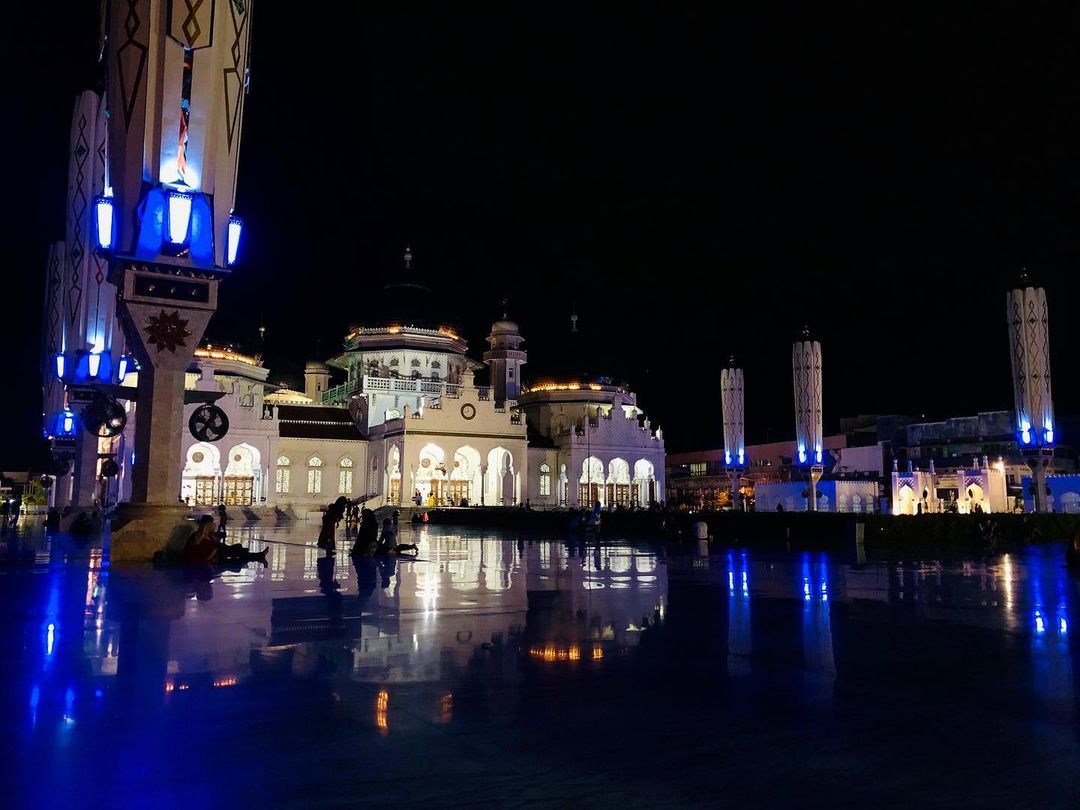
The colorful LED lights on the umbrellas give the mosque an enchanting aura in the evening
Image credit: @abou_tree
Today, the mosque stands as the symbol of Aceh and its people, known for being the most religious in Indonesia, especially after the region was hit by a massive tsunami in 2004. The mosque was one of the few buildings left standing in the city and the people took this as a sign of divine intervention, which further cements the mosque’s reputation among Acehnese and Indonesian Muslims in general.
Ironically though, the mosque had a rocky start as the Acehnese refused to pray here when it was first built, given that it came from the hands of Dutch colonials. Do note that unlike the mostly secular majority of Indonesia, the Aceh province adopts strict Sharia law and we recommend doing your research on the do’s and don’ts first if you’re thinking of visiting.
Address: Jl. Moh. Jam No.1, Kp. Baru, Kec. Baiturrahman, Kota Banda Aceh, Aceh
Opening hours: 24 hours, Daily
Some ground rules when visiting these unique mosques in Indonesia
All of these mosques in Indonesia are still being actively used as places of worship for Muslims but interested non-Muslims are still allowed inside the premises, provided they abide by these rules:
- Wear appropriate clothes that cover the intimate parts of the body, known as aurat. For men, this means no sleeveless tops and no shorts while for women, only the face, the palms of your hands, and the bottom of your feet can be left uncovered. Additionally, while women aren’t required to wear the hijab, you must at least cover up your hair
- There’s no definite ruling on whether women on their period are allowed inside the main praying area or not. Just to be safe though, we recommend you stay outside if you’re on your period
- Mosques are typically gender-segregated with males and females having their own wudhu and praying areas, and you must be aware of which is which
- Make sure that you’re properly clean when entering the praying area. Each mosque has a dedicated area for wudhu, a mandatory purification ritual done before prayer, and if you’d like, you can clean yourself up here as long as you don’t intrude on the worshippers
- When entering the praying area, typically marked by the sign batas suci, meaning sacred space, make sure to take off your shoes and sandals but socks are still allowed. If you see any Muslims praying, keep your distance or at the very least, don’t walk in front of them. Additionally, Quran recitations are regularly performed in mosques and they are not to be disturbed
- Keep your voice down around the mosque, act courteous, and avoid public displays of affection
- If you’re thinking of going, know that Friday at noon is when Muslims perform their Friday prayers and that mosques in Indonesia are always filled to the rafters during this time
Unique mosques in Indonesia to visit
If continental Europe has their cathedrals and churches, Indonesia has its own fair share of mosques. While the archipelago’s natural beauties are usually the main attraction, these 8 unique mosques in Indonesia are just worthy of a visit.
For more tourist spots to hit around the country, check out these stories:
- 8 stunning waterfalls in Indonesia to visit
- Things to do in Borobudur, including sunset-watching and river rafting
- 8 water villas in Indonesia that’s just as good as Maldives & Bora-Bora
Cover image adapted from @dienawasool_dienakitchen, @paparafa99, and @lukiiiiluk
